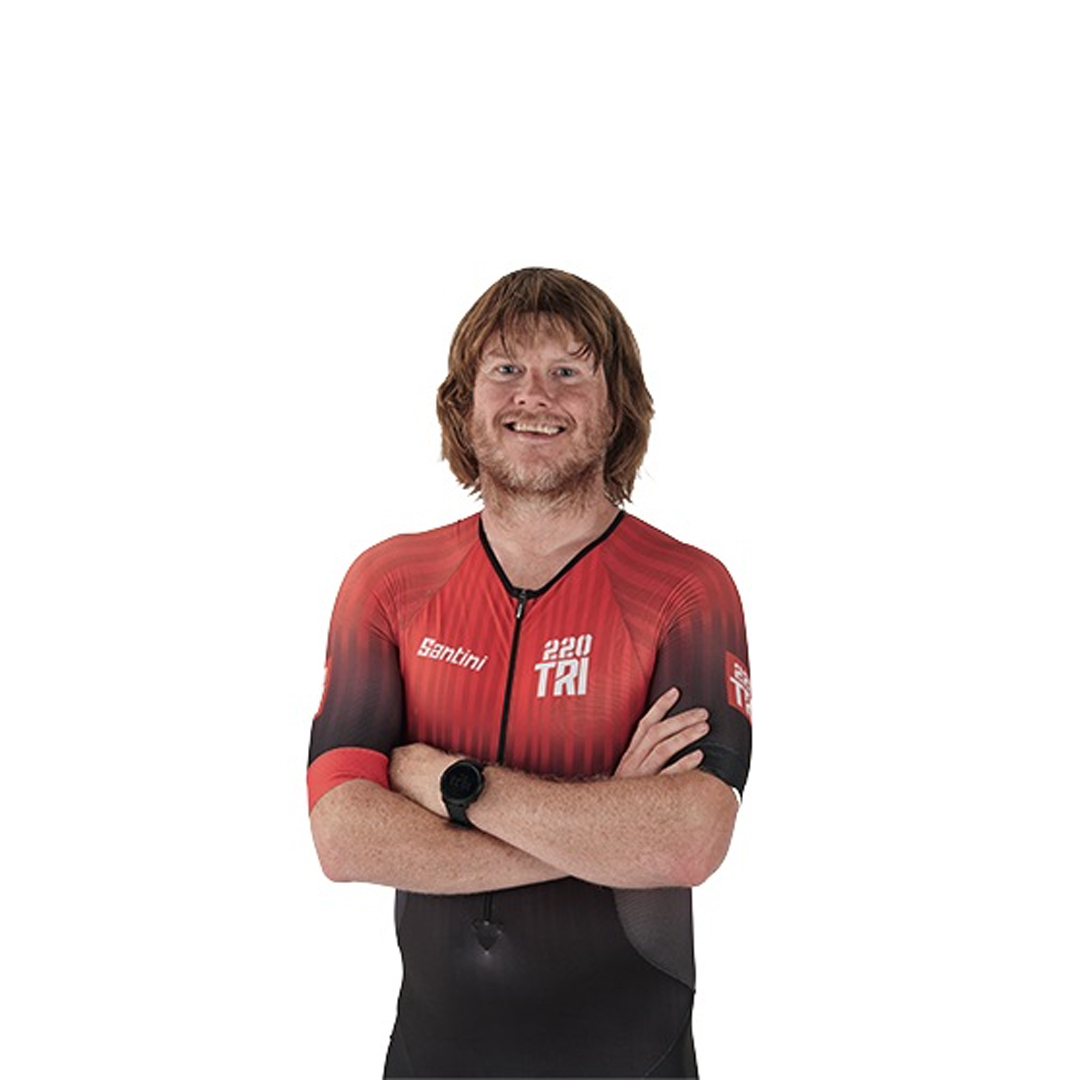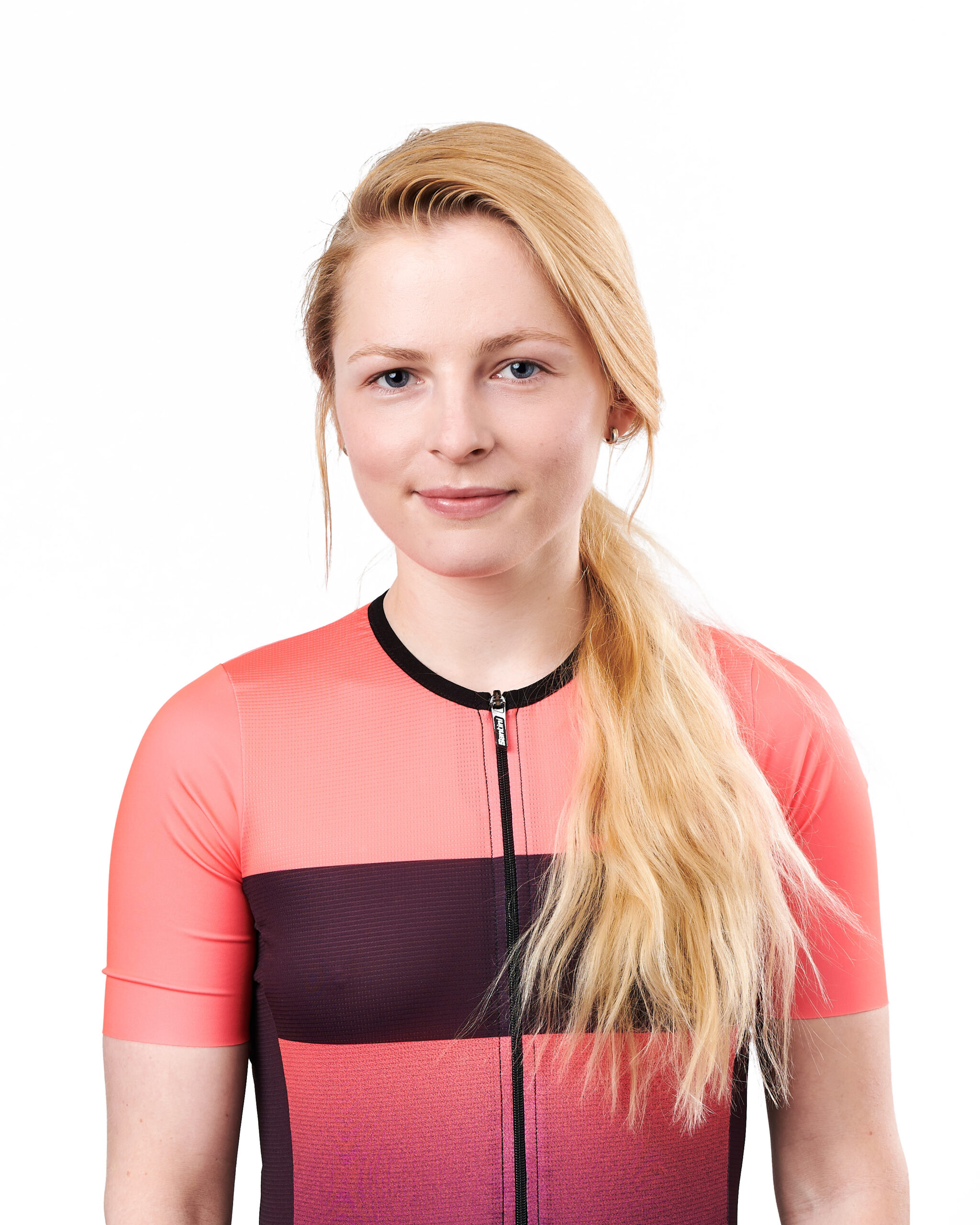All being well, by the time you read this you’ll be one step – one stride – closer to swapping your overused training kit for your dust-collecting race apparel.
To celebrate the new normal, you can instead put the duster away and bag yourself sparkling new gear. Once you know how to choose triathlon running shoes, you'll be making strides with your new kicks...
What are the best shoes for running?
As triathletes, we know that weight matters. Which is why a pair of lightweight road running shoes really can pay off. Okay, we may only be talking 100g or so per shoe over your training shoes, but throw in a cadence of around 120 strides per minute over 5km, 10km, 21km or 42.2km, and that soon adds up.
If those weight savings are equal to energy savings, in theory race-day trainers mean not only faster leg turnover, but glycogen saved for the final push, too. We say ‘in theory’ as these aren’t for everyone. Beyond weight, triathlon-specific features include elastic laces, drainage holes and heel loops.
The best race-day running shoes for men
Under Armour Flow Velociti Wind 2
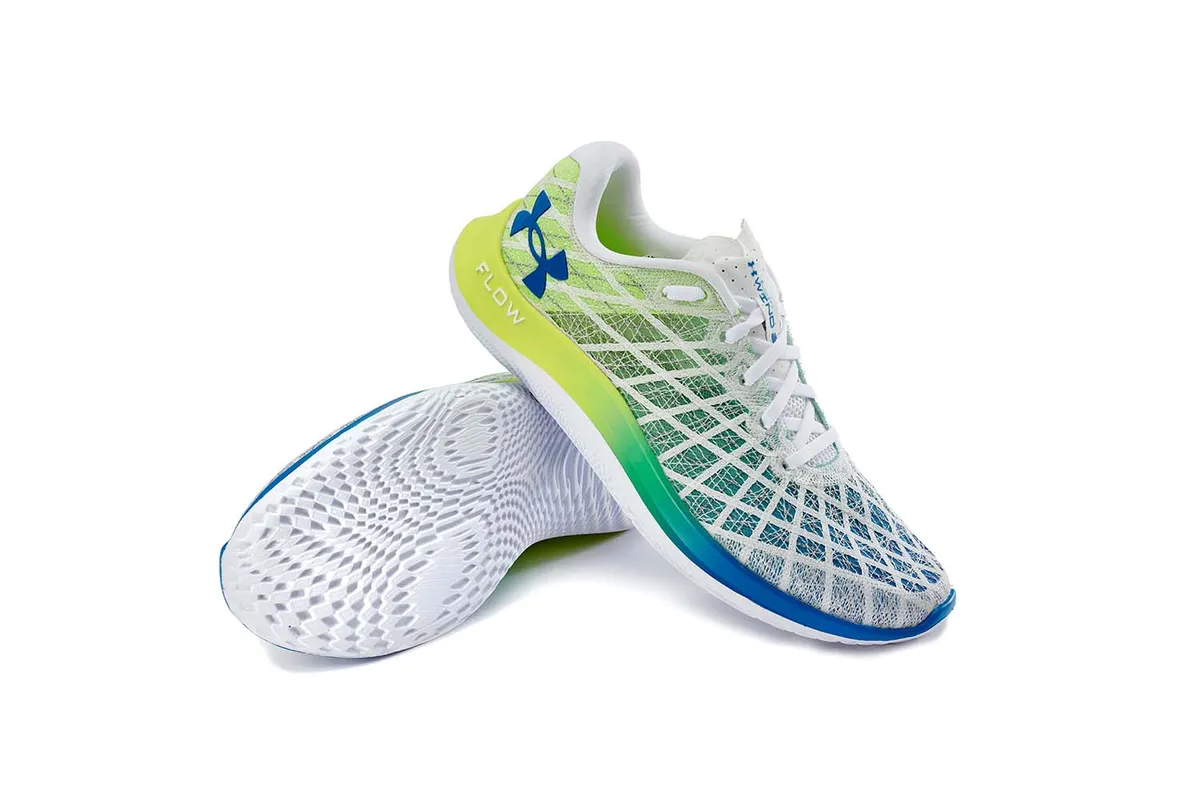
- £140
The Flow Velociti 2 is a hugely fun shoe, and it’s one that we returned to more than any other on test. Triathlon friendliness comes in the breathable mesh upper and sockless comfort, and the visuals feel classic tri.
In a bid to lose weight – the 236g (UK7) is pretty lean – a conventional rubber outsole is missing and we do have (currently unfounded) long-term concerns over the outsole material’s grip and durability.
The feel is responsive yet cushioned (the heel height is a moderately high 28mm) and, though they lack the sheer toe-off propulsion of the Nikes or Kipruns here for sprintdistance tri, Olympic and middle-distance feels about right.
A smart linkup with MapMyRun also offers a host of metrics, including cadence and stride length to complete a versatile if slightly pricey package.
Verdict: Classy upper, moderate spring and classic tri styling make these a winner
Score: 87%
361° Kairos
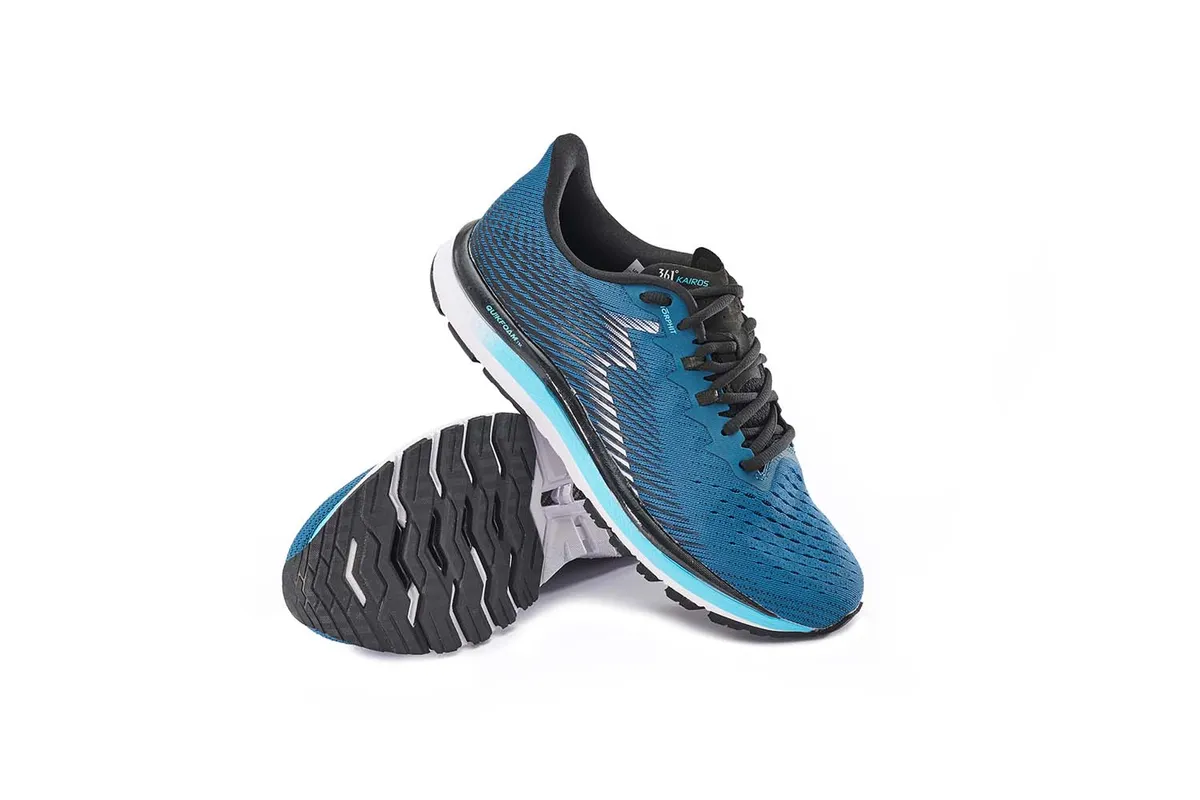
- £124.99
Durable, supportive and stable, the Kairos really is a shoe that’s hard to fault. So why an anticlimactic air? Speed. These kicks are more suited to grinding out the training miles than pursuing PBs on race day.
Granted, there’s what feels like a minimal heel-to-toe drop (the exact number is undisclosed) and tri ‘racing’ can involve Ironman run leg survival, but speed seekers should look elsewhere.
Plus points include a classy mesh upper and a supple tongue that offers plenty of cosy coverage. There’s a shank running through the midfoot that successfully increases stability, yet the result is more efficiency rather than propulsion.
We’re still unconvinced about the extended heel collar, but there’s plenty of evidence that the Kairos will make a long-lasting training shoe. Weight is a lofty 274g (UK7), price a happier £125.
Verdict: A solid, durable and supportive shoe that's best suited for training runs
Score: 77%
Kiprun Ultralight
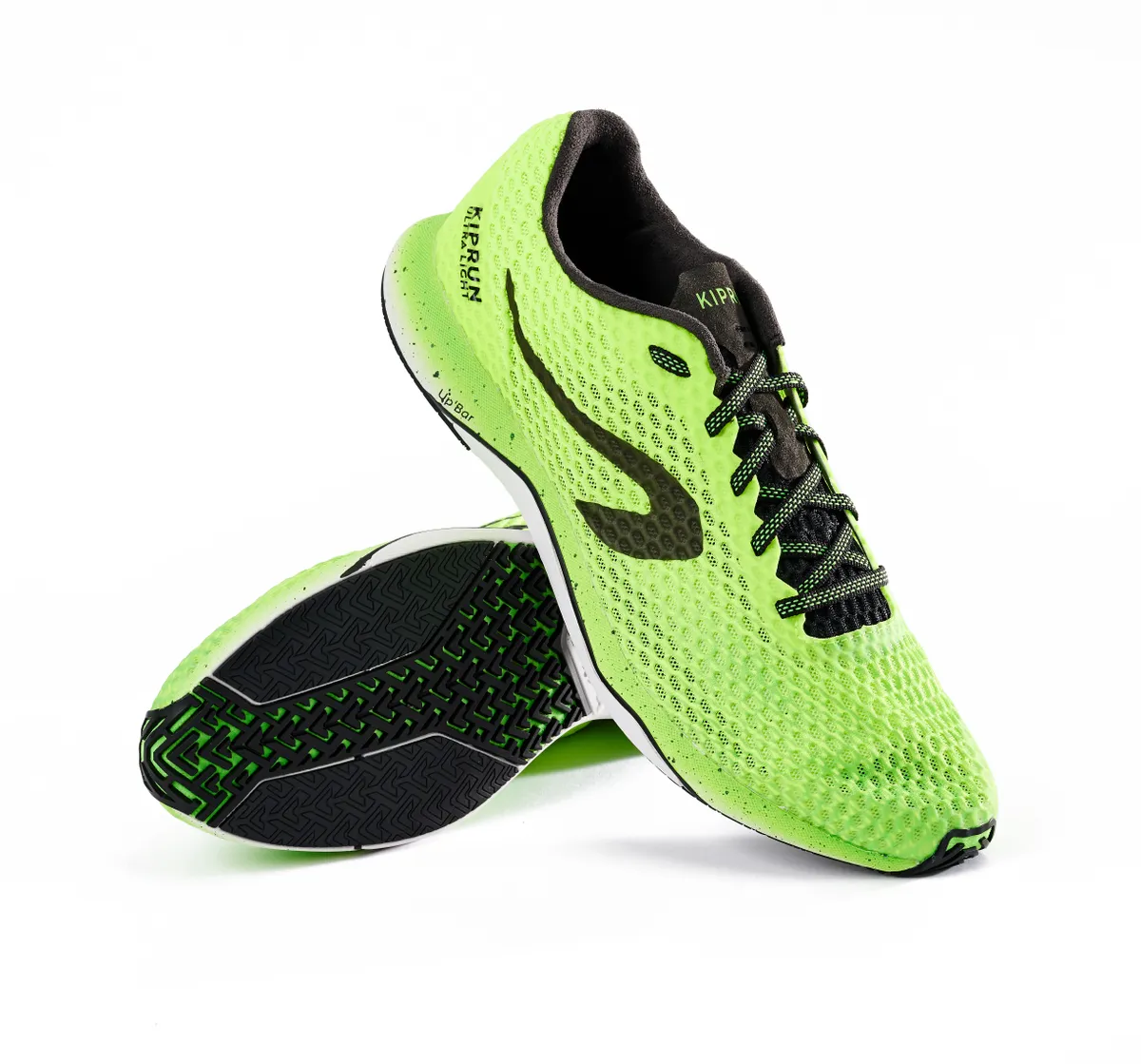
- £69.99
The Ultralights romp to the Best Buy title in this test. Put simply, they’re an absolute steal for the sub-£70 price tag and gave us utter joy every time we slipped them on for a speed set (sockless, thanks to a near seamless upper).
Key to the thrills is the 185g (UK7) per shoe weight, a featherlight amount that adds to the forefootencouraging nimbleness, which had these leading the pack in interval sessions and race-day 5/10km prep (10km would be our limit).
And yet we didn’t crock ourselves, using them day after day thanks to Decathlon’s Up’Bar technology in the midsole.
Less positively, the grip isn’t great in the wet, the laces are due an instant upgrade and we do have concerns over the outsole’s longevity, but as a breathable, lean, swift and yet hugely affordable shoe, there are few better.
Verdict: An absolute bargain buy for short-course speed. Just watch out when running in the wet
Score: 86%
Newton Distance Elite 21
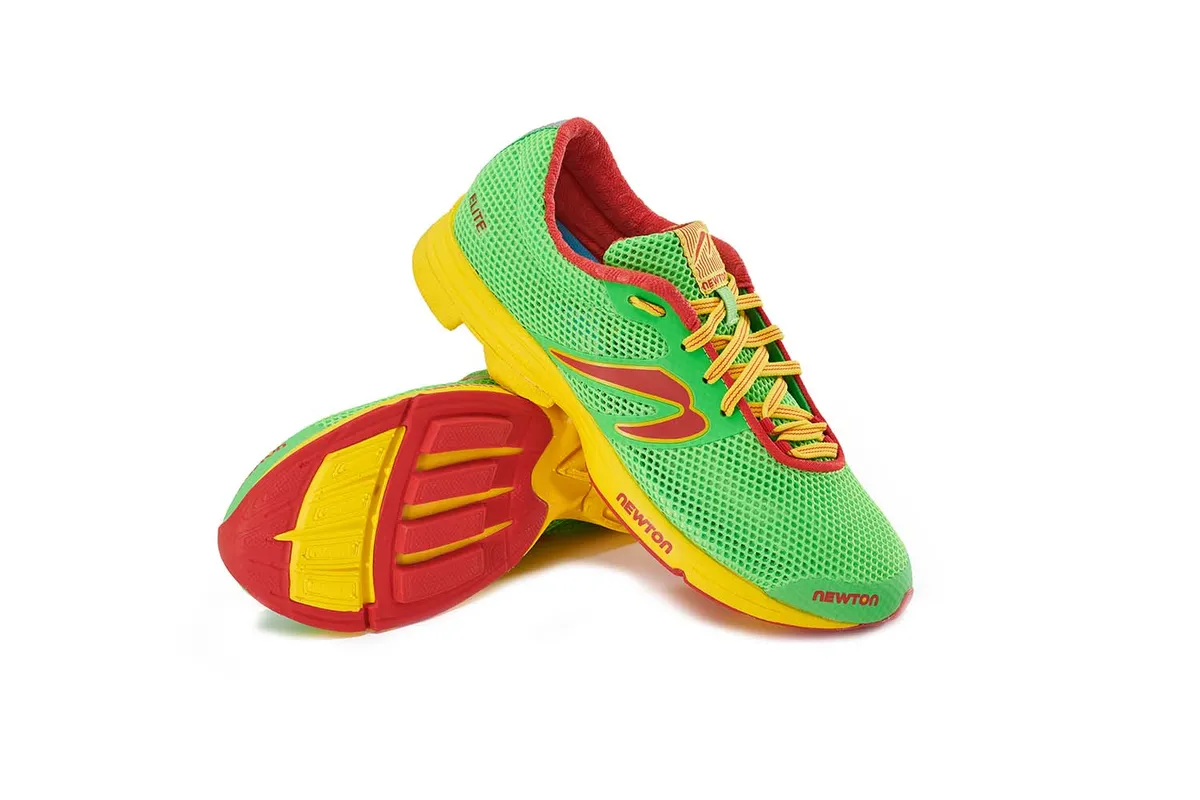
- £150
Newton were a big deal in 2008, their innovative metatarsallugged soles leading Craig Alexander to multiple Ironman world titles. Those lugs became the brand’s USP and also its Achilles heel, and Newton soon became superseded by the minimalist and maximalist movements.
Is it time for a genuine return from the margins? With minimal heel cushioning, the Distance Elites certainly encourage a forefoot strike, their 2mm heel-to-toe drop rewarding those with elite technique – sadly, we lost efficiency with tired legs especially.
Those metatarsal lugs do cushion and propel landings, however, and the 213g weight (UK7), colour scheme and breathable upper shout tri race day. That mesh upper feels delicate and can shift laterally a little, while the £150 price tag for such a minimal shoe feels hard to take.
Verdict: One for pure speedsters, but likely to be too minimalist for many age-groupers
Score: 74%
Nike Air Zoom Alphafly Next%

- £279.95
The 207g (UK7) Air Zoom Alphafly Next% look and feel like no other trainer on Earth. We could write an essay on the visuals alone – part deer hoof with a smidgen of toothbrush on the forefoot’s outsole – that had us initially running under the cover of darkness.
As for the performance? If the evident propulsion and bounce factor were good enough for Eliud Kipchoge when breaking the two-hour marathon barrier, they should be good enough for me. And yet we’re lukewarm to the idea of them being a tri race-day option.
They struggle on the tight twists and turns of multi-lap circuits, while unruly surfaces are best avoided. It just feels like too many ideas – carbon plate, Zoom Air Bag and wedges of foam – have been fried up in Nike’s mind wok. The price is bonkers and they’re noisy devils but there is a wonderful upper.
Verdict: Ambitious and outlandish, but we're unconvinced of tri appeal and reeling from that price
Score: 80%
Hoka One One Rincon 3
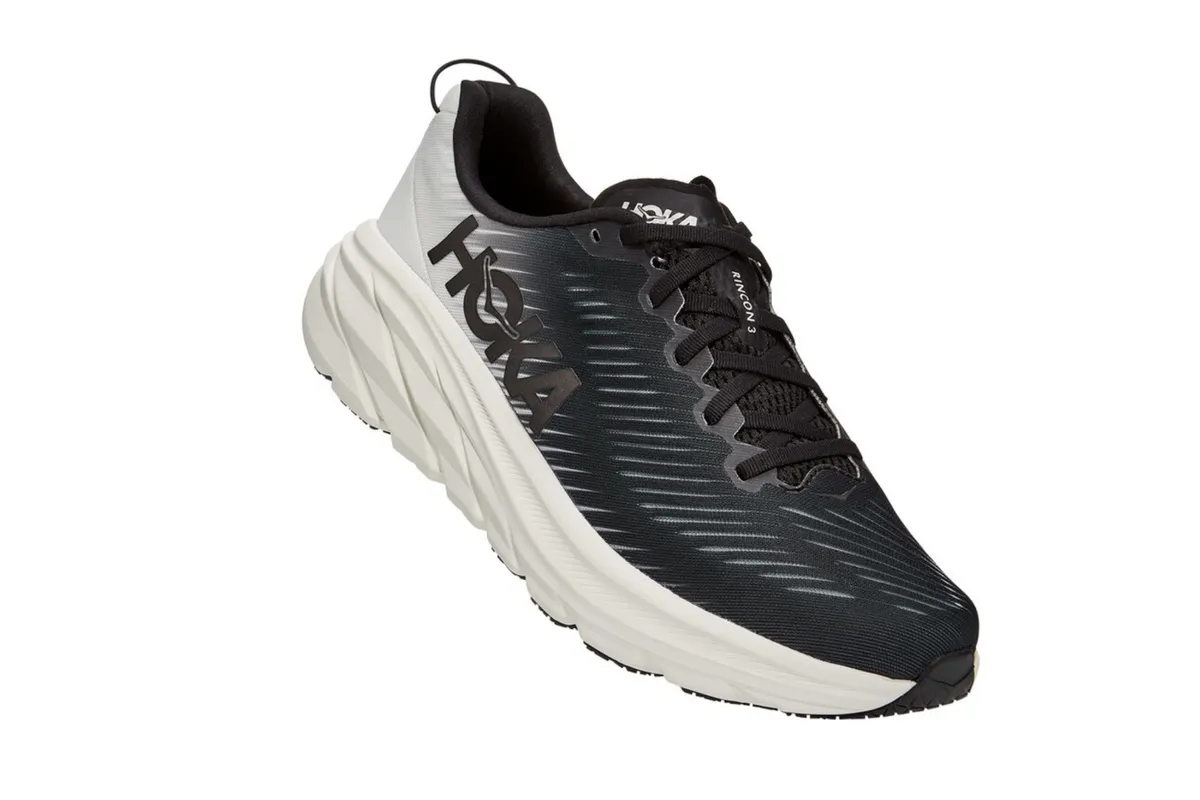
- £105
Fondly remembered by boys of a certain age, the plot of Weird Science involves two high school kids creating their dream woman. Swap those computer nerds for a pair of serious triathletes and the resulting creation could well have been the Hoka Rincons 3, as they tick every box for multisport.
They’re impossibly light (197g for a UK7) yet cushioned, suitable for training and racing from 5km to the Ironman marathon, with swift drainage, a breathable upper and even a heel loop and race-focussed tongue.
After the gentle refinement of the still impressive Rincon 2s, the 3s have seen more of an overhaul. Weight comes down thanks to the ultra-slim asymmetrical tongue, outsole grooves and slender mesh upper, and it’s now available in standard and a new wider version.
But it’s long-term durability, an oft-cited criticism of previous Rincons, where the major overhauls have taken place. Extra rubber has been added to the outsole and the midsole has been reinforced, yet not at the expense of propulsion from the Meta-Rocker.
The heel-to-toe drop is Hoka’s standard 5mm (heel height is 29mm), but there’s nothing just standard here. These are Hoka’s best shoe yet.
Verdict: A barnstormer for Hoka fans new and old. And at a decent price, too.
Score: 94%
Under Armour Flow Velociti Wind
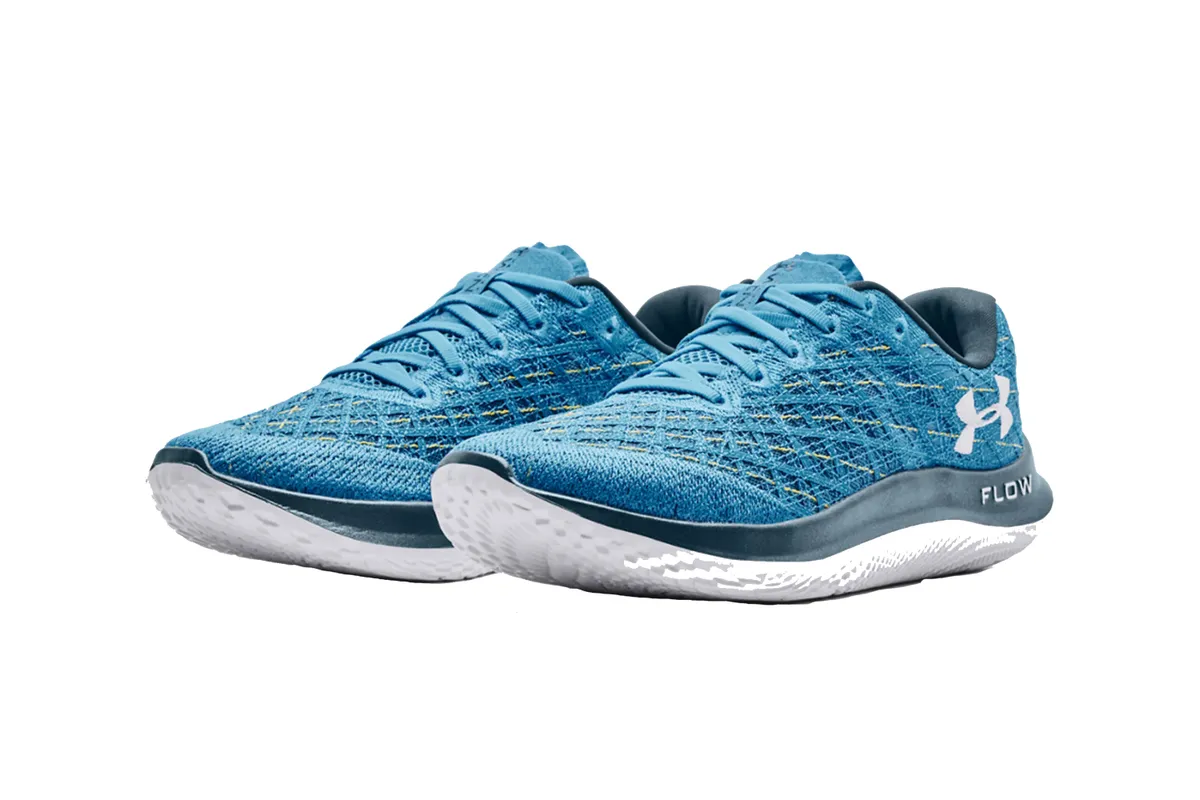
- £125
If the last year’s several lockdowns were characterised by long, steady runs to get out of the house (and to take a break from Zwift), then the impending end of lockdown has to be characterised by a renewed optimism at the prospect of returning to racing – and the associated return to speed training.
With that in mind, we’re also swapping out our muddy trail shoes for something a bit lighter (see p57 for our race-day run shoes grouptest), which is where the new shoe from Under Armour sits well.
Designed with light weight at its core (227g for a women’s UK7 as tested here), the designers have done away with the rubber outsole, replacing it with the ‘UA Flow’ foam, which aims to be lightweight yet sticky on all surfaces. With an 8mm drop, this shoe had a traditional feel which we appreciated, and we liked the springy, propulsive feel.
They do flex on toe-off rather than having a more ‘rocker’-like design (as seen in Hokas et al.) yet the soft lining and light mesh fabrics make them a good choice for running barefoot in triathlon – just add a set of triathlon laces for speed.
We did find we got a bit of a hot spot on the bony top of our feet where the laces tied over a padded tongue section, but a pair of socks solved that problem, (which we’d want for longer distances anyway). Helen Webster
Our only other issue was that the curved sole made us feel a little bit unstable at first, but we quickly adapted.
Verdict: Light, breathable shoe that has a lot to offer for PB-hunters.
Score: 80%
On Cloudboom Echo
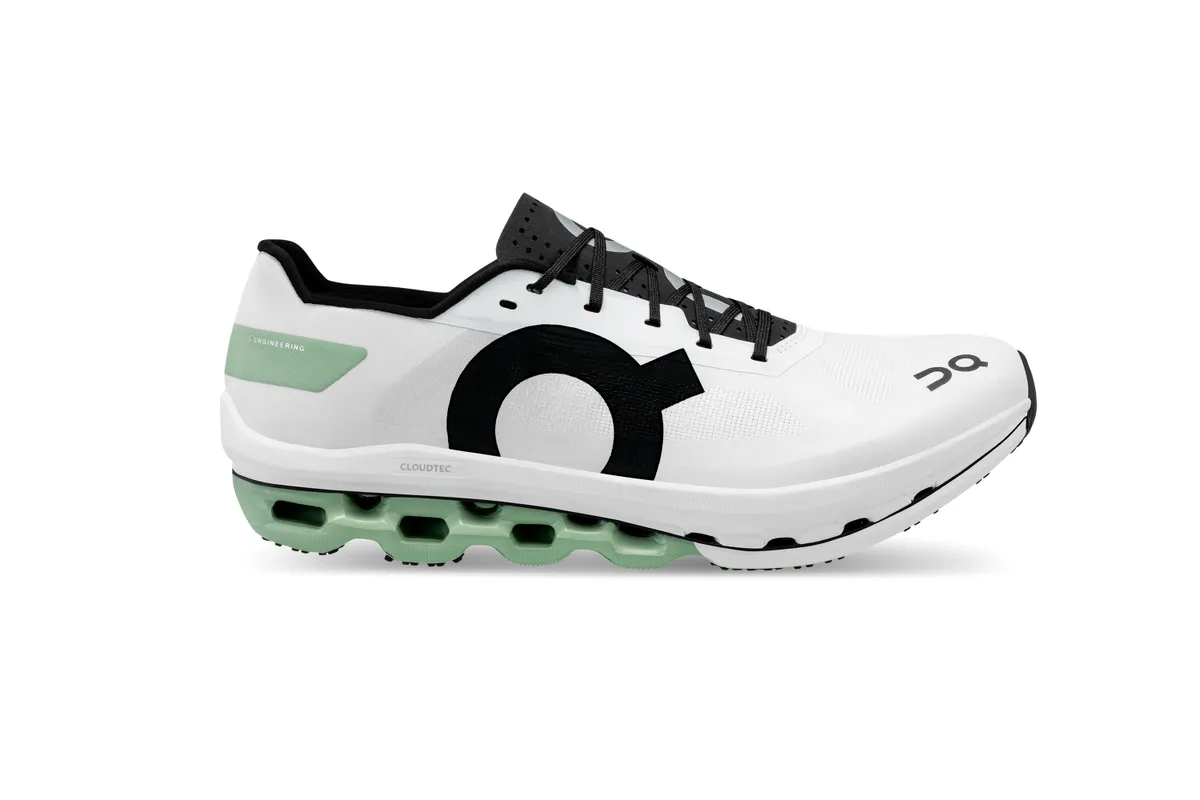
- £210
Slip on these sleek, wafer-thin kicks and you’ll feel the propulsion from the very first step. At only 186g (per shoe, UK size 5.5), the Cloudboom Echo really is ‘shaped for speed’.
These shoes feel extremely light, with an almost translucent 100% recycled polyester mesh upper and light foam midsole. Simply by shifting your weight to your forefeet from standing, you’ll feel the extreme rocker thrusting you forwards and into motion.
While we wouldn’t wear these to log super long training miles, the Echo was made to compete and requires less energy to run fast than your typical sub-£100 road shoe.
Those aiming for the lightest and most responsive ride can’t do much better than investing in a pair of these marathon speed machines. Kate Milsom
Verdict: Incredibly high-tech and fast marathon runners, but pricey.
Score: 94%
Hoka One One Clifton 8
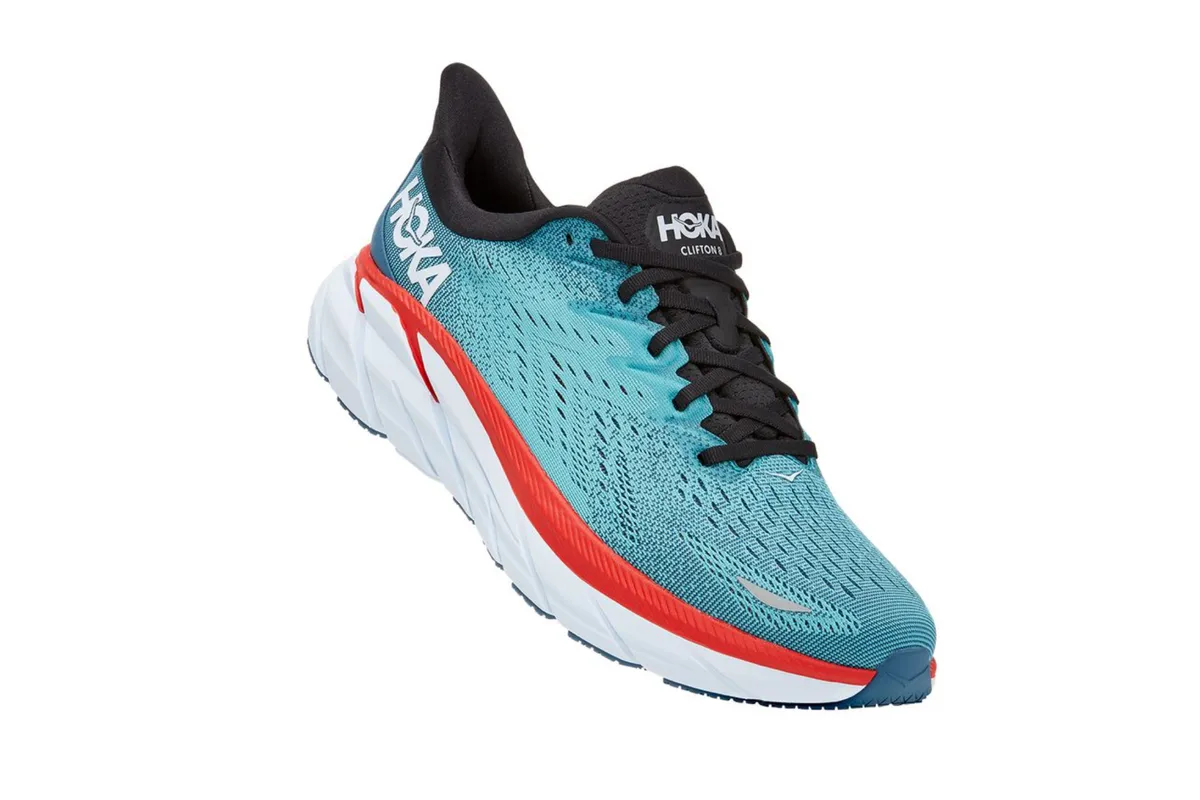
- £125
The Clifton is arguably the quintessential Hoka shoe. It was given an overhaul in 2020 and receives one again in 2021. The Clifton 8 boasts a new upper, outsole and midsole.
The latter is 15% lighter than the Clifton 7’s midsole foam, yet the shoe is somehow a little heavier (though still light at 250g). A stack height of 29mm and a 5mm drop remain, as does that oversized heel tab of which we’re still yet to see the benefit.
What also remains is just how comfortable this shoe is for logging the long, slow-to-mid tempo miles (we can also see Ironman run leg appeal), with the comfort aided by the soft mesh upper and supportive foam. Good, then, but this tester’s still a Rincon man.
Verdict: Welcome updates make this one of the better Cliftons
Score: 85%
Scott Speed Carbon RC

- £170
From the brand’s DH tri-bars to Ali Brownlee’s Plasma 6 triathlon bike, Scott has a long heritage in multisport innovation. Yet it’s far from the first to the party when it comes to carbon-soled run shoes.
So does this loud latecomer have enough tech wizardry to stand out from the increasingly-crowded carbon market? The Speed Carbon RC shoes come after a reported 10 years of continued R&D which, for a run shoe, displays either a painstaking pursuit of perfection or some serious gestation issues.
The key specs are a Carbitex DFX carbon fibre plate in the midsole, an Evolved Rocker2 for forward propulsion and the Kinetic Light Foam, which keeps the weight of the shoe down to 250g despite a high 30mm heel height.
The heel-to-toe drop is a relatively low 5mm. It’s the above numbers that make Hoka’s Carbon X our point of comparison; both are lean yet oversized, both encourage a fore/midfoot strike and both don’t come cheap (£160 for the Hokas).
Yet the Scott seem to belong in the 5-15km category. They’re great going down and up hills, too, but they lack the Hoka’s long-course versatility. No matter how many times we ran in them or tried various lacing combinations, they just failed to secure the back of our feet (possibly due to the incredibly thin materials).
This looseness led to inevitable sore spots and a reluctance for us to fully hit top gear. Hopefully this’ll be sorted when the inevitable Carbon RC sequels arrive as there’s much to admire, especially in the midsole and vented upper.
Score: Propulsive midsole and quality upper, let down by loose ankles.
Verdict: 77%
Scott Pursuit
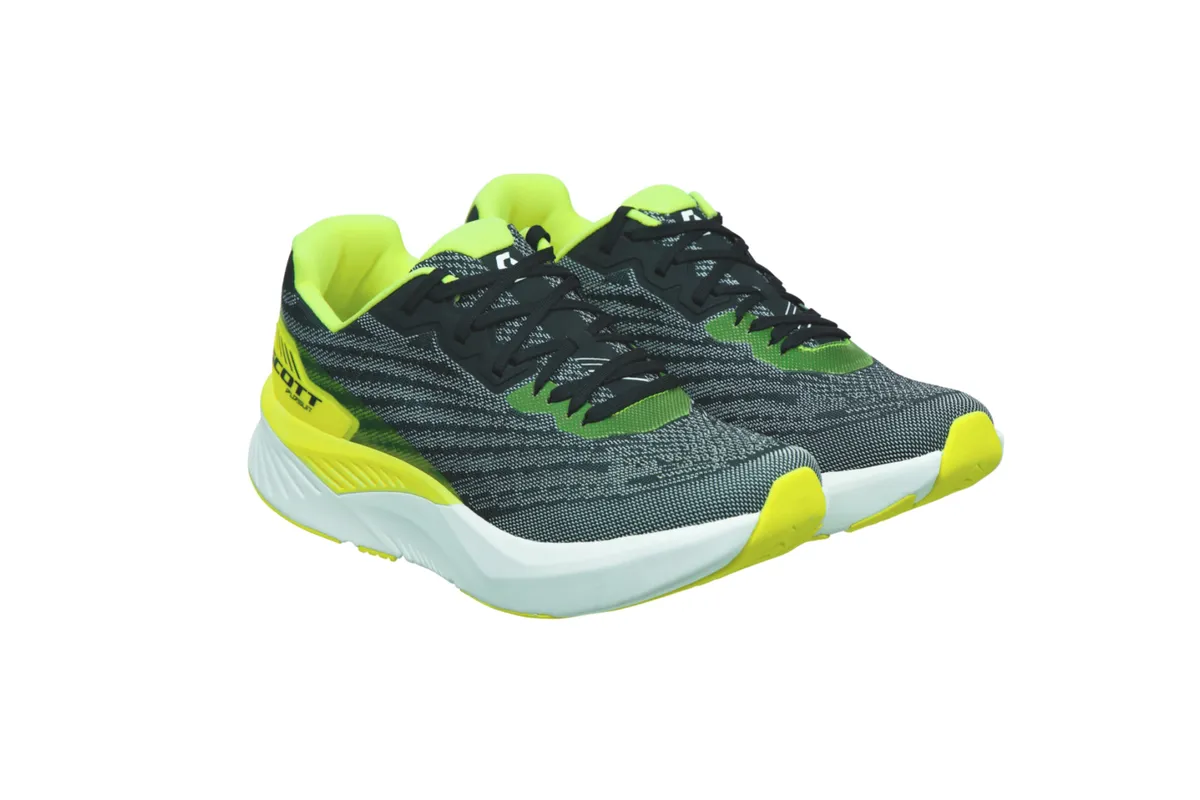
- £130
In the rugged, racy and durable Kinabalu and Supertrac, Scott have produced this reviewer’s current favourite trail shoes. And yet we’ve never clicked with the brand’s limited road range, which has for 2021 clearly been influenced by the oversized shoe movement (surely here to stay).
Released at the same time as Scott’s Speed Carbon RC (£170, see issue 395), the Pursuits boast the same hefty, supportive yet lightweight midsole wedge (heel height is 30mm, heel drop 8mm and overall weight 236g for a UK 7) and they’re certainly worthy of the ER2 Evolved Rocker tag as there’s plenty of forward propulsion.
Similar to the Rincon 3s, there’s a quality one-piece mesh upper that’s breathable and durable, though we ditched the cheap supplied laces right away. So far, mostly so good, but once again we had trouble indoors.
Where the Speed Carbon had a lack of security in the heel, the Pursuits have a very high arch, which caused intense rubbing on our instep from about 5km onwards, no matter how much we applied lube or broke them in. Supinators or runners with high arches might not fare as badly, but trying before you buy is essential here.
Verdict: Impressive midsole and upper, but internal issues
Score: 74%
Hoka One One Rocket X
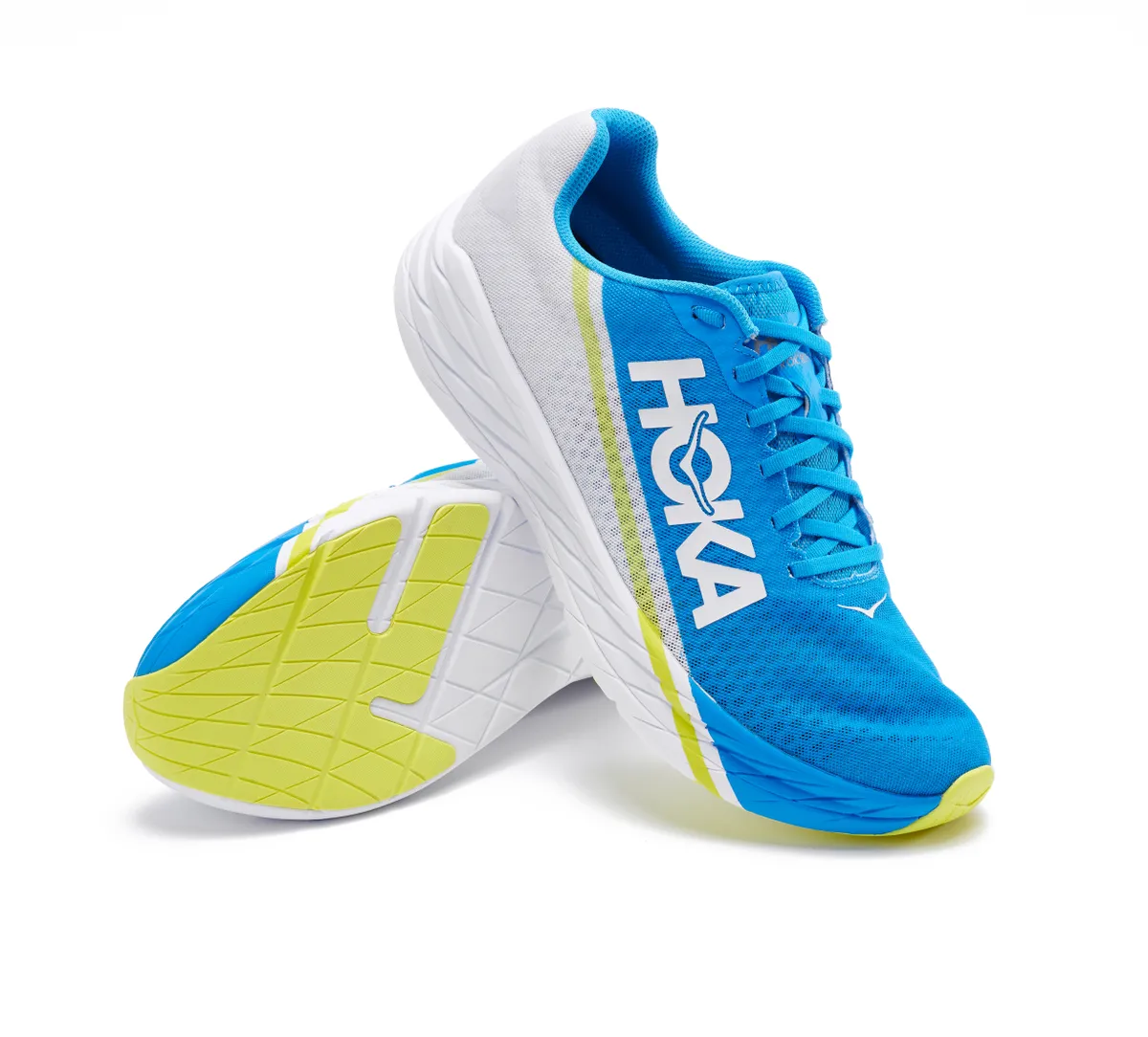
- £160
The run-shoe phenomenon of recent years describes this shoe as an “insanely responsive racer geared for elite athletes”. As this ageing age-grouper can testify, it’s not solely the peak of the performance pyramid who’ll benefit from the Rockets, as these are durable and comfortable enough to train in, even proving their worth up to half marathon.
Their 234g weight defies their far-from lithe looks and comfortable feel, and that’s thanks to Hoka’s ‘lightest foam they’ve ever used’. We can only agree, especially when the shoe features a carbon plate for added rebound force, enhanced further by Hoka’s MetaRocker.
This tester would still stick with the lighter-weight Evo Rehis for racing, but that’s a personal preference and doesn’t detract from a cracking shoe.
Verdict: Another fine mile-muncher from the Hoka crew
Score: 84%
Brooks Ricochet 3
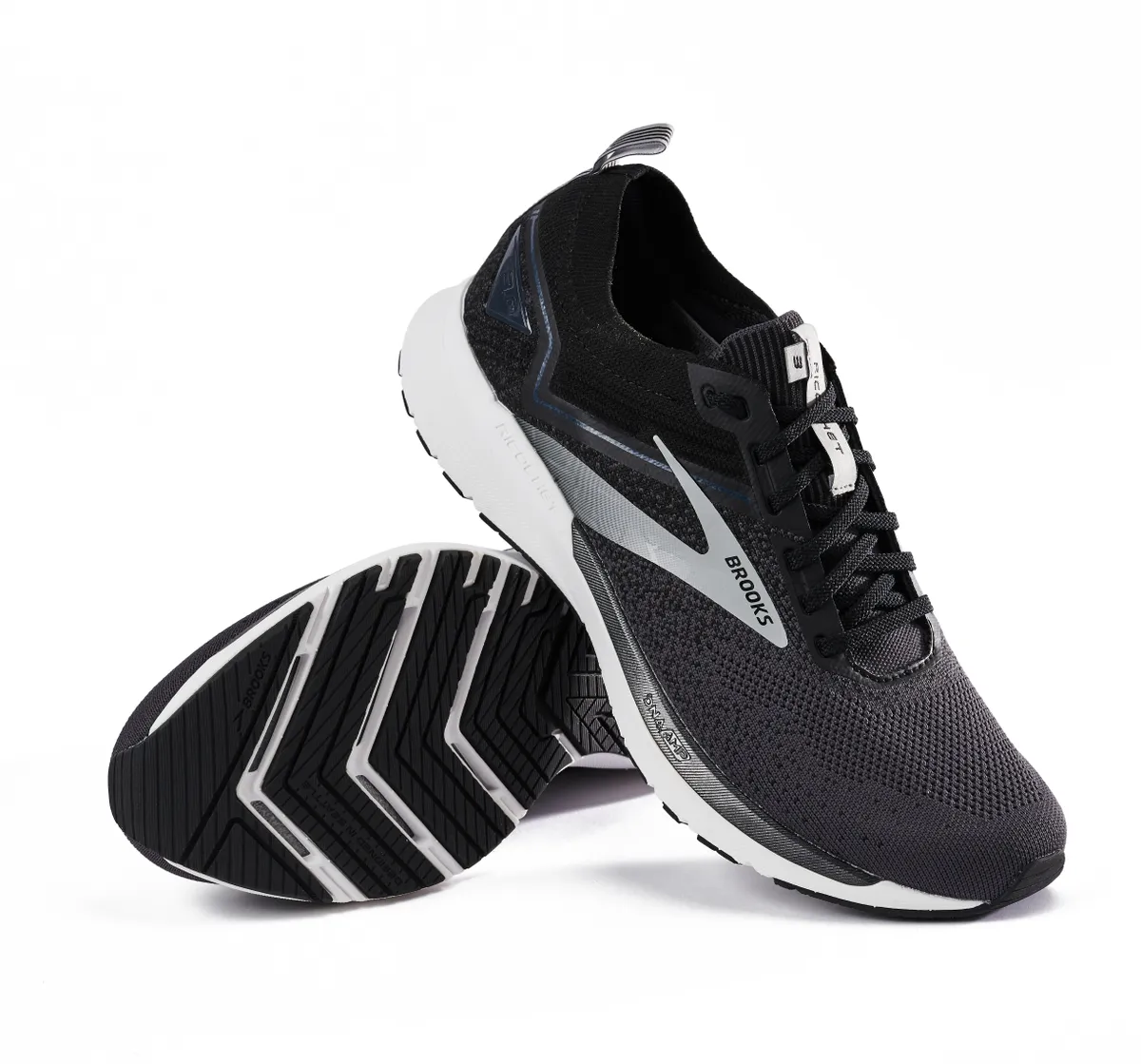
- £120
We’ll admit, we have a soft spot for Brooks after an older model helped ease our long-standing ITB issues and rectified our sloppy gait. We’ve found Brooks to be one of the comfiest shoes around, and so it is with the Ricochet 3.
The woven upper, minimally stitched inner and sewn-in stretchy tongue cradle your tootsies like its life depended on it. Throw in the tried-and-tested combination of DNA AMP and BioMoGo DNA cushioning and you have the most comfortable shoe on test.
The problem is, at 309g they’re just not designed for top gear. Yes, toe-off is springy and propulsion is good. But when it comes to the marginal gains over Olympic distance and lower, it falls short. Still, a possible for half-IM and above (it has a heel loop!). And definitely for training
Verdict: Would contend for best training shoe...but this is for race day
Score: 80%
Skechers GOrun Ride 8
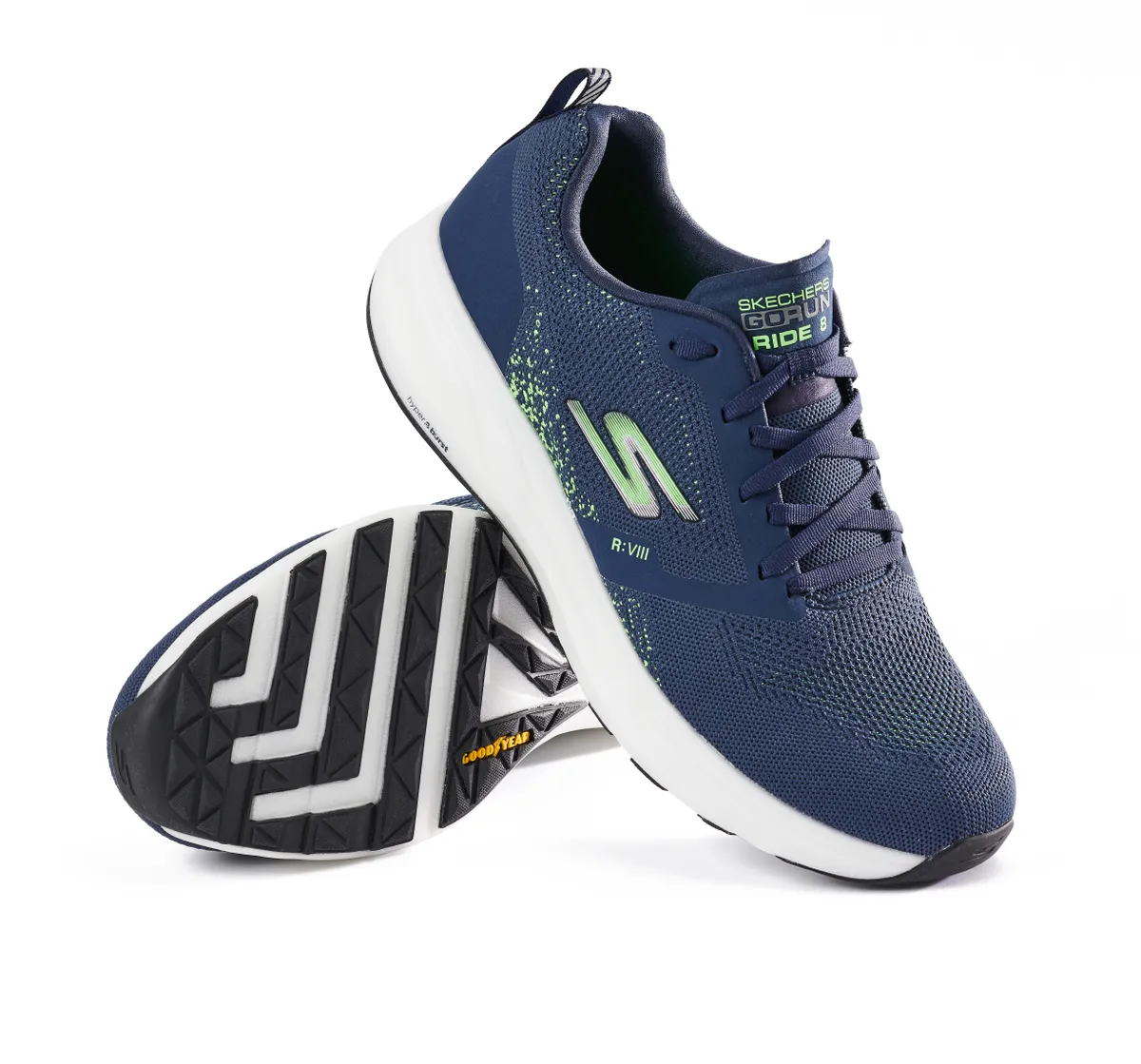
- £110
First up, we’re not a fan of the Ride 8’s looks; in fact, they’re reminiscent of the budget run shoes our mum would buy us as a youngster. But that’s just us. More importantly – the ride.
They’re 316g – not light – and feel more like a training shoe than racer. Arguably, that’s down to the 6mm drop that’s packed with the company’s Hyper Burst midsole. It’s a cushioned foam number that purportedly lowers weight.
It doesn’t, but it does heighten comfort; that said, a rather stiff heel counter takes a little getting used to before bedding in. The neatly woven upper’s highly breathable.
In theory, this’d suit barefoot race running but no socks equals no comfort, so we’d advise against. They’re efficient, though not fast, so an option for miles over maximum momentum.
Verdict: Moderate training shoe that lacks a certain spark
Score: 71%
Saucony Type A9
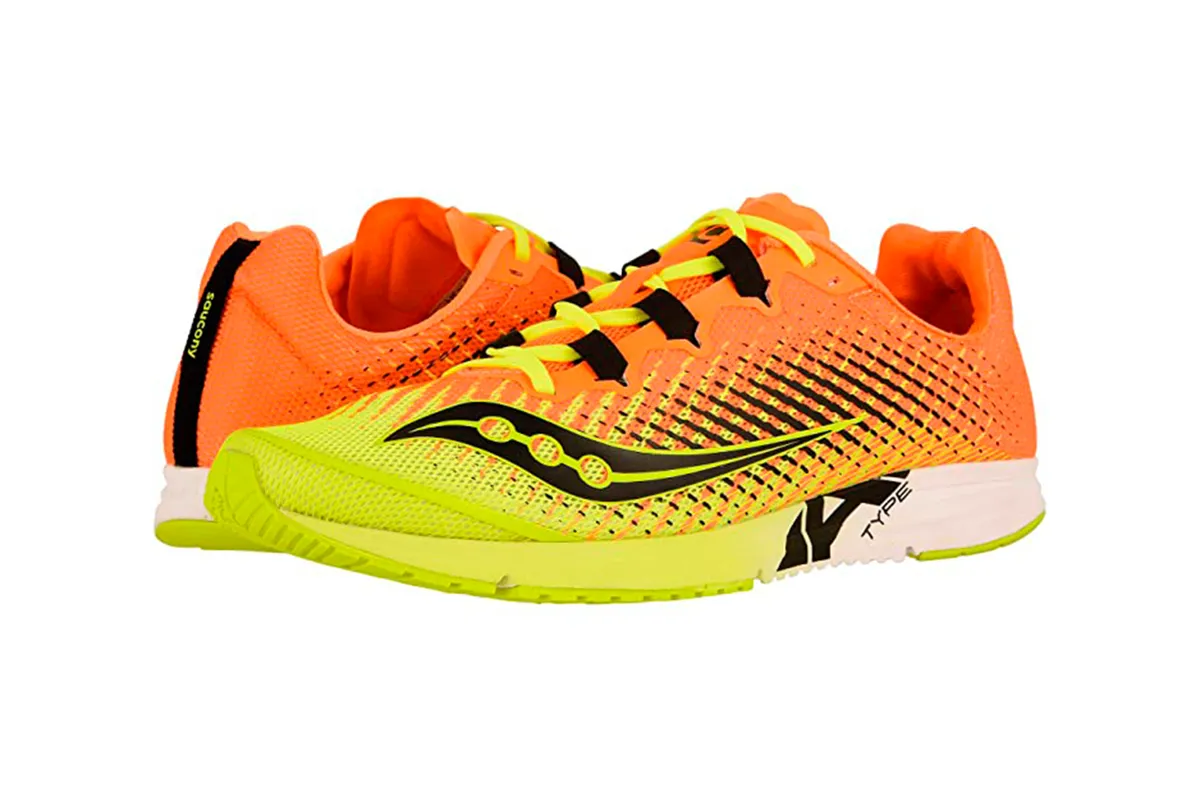
- £100
The Type A9 is an out-and-out racer. And a damn good one at that. It’s the lightest on test at 197g and one of the loudest. That’s a good thing as racing’s not a place for the meek of heart.
Comfort is high for such a stripped-down shoe, yet the 4mm drop hints at a modicum of cushioning that derives from the Super Lite EVA midsole. That said, it’s not enough to have us slipping into these for 70.3 and above.
Fit is excellent. We put that down to a thin fabric skeleton within the shoe that clamps to your feet when tightening your laces. It’s a simple idea but works well. The upper breathes well, too.
Verdict: Speed and comfort for Olympic distance and below
Score: 89%
Asics Gel-DS 24
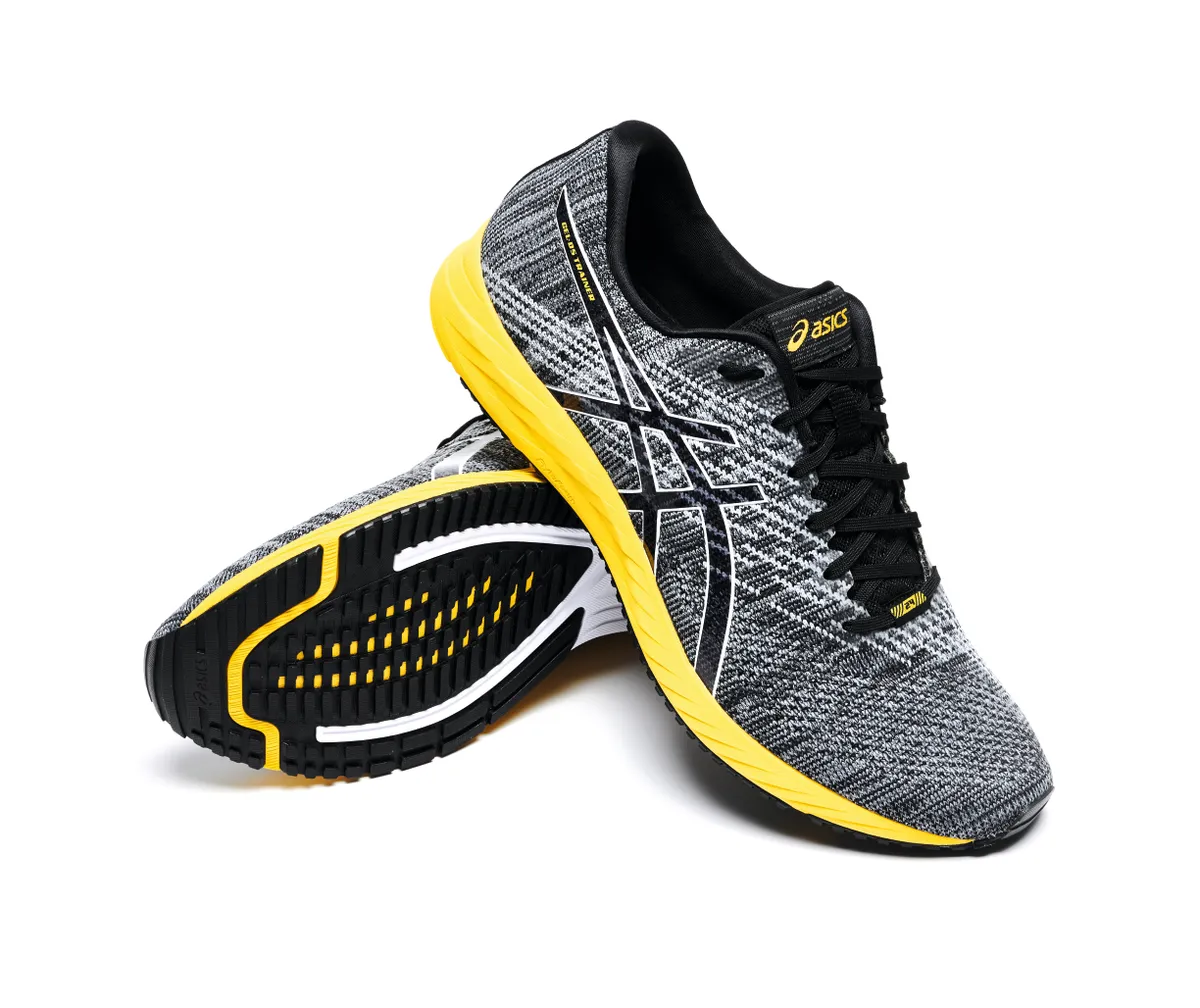
- £120
The DS are now at chapter 24. But are they improving with age? They’re the comfiest here, with a solid heel counter stabilising your feet that’s then cradled by an EVA sockliner.
This is a midsole forged from two different densities of material that dampens the impact of landing and also smooths out pronation issues. Transition from landing to toe-off is proficient, and maximised via a band beneath the midsole that prevents twisting and torsion.
You do feel fast in the DS, though not up there with the Saucony, which comes down to weight. At 282g, these are over 90g heavier than the Type A9.
Verdict: A comfy and swift shoe for the heavier triathlete
Score: 81%
New Balance 1500 T2 BOA
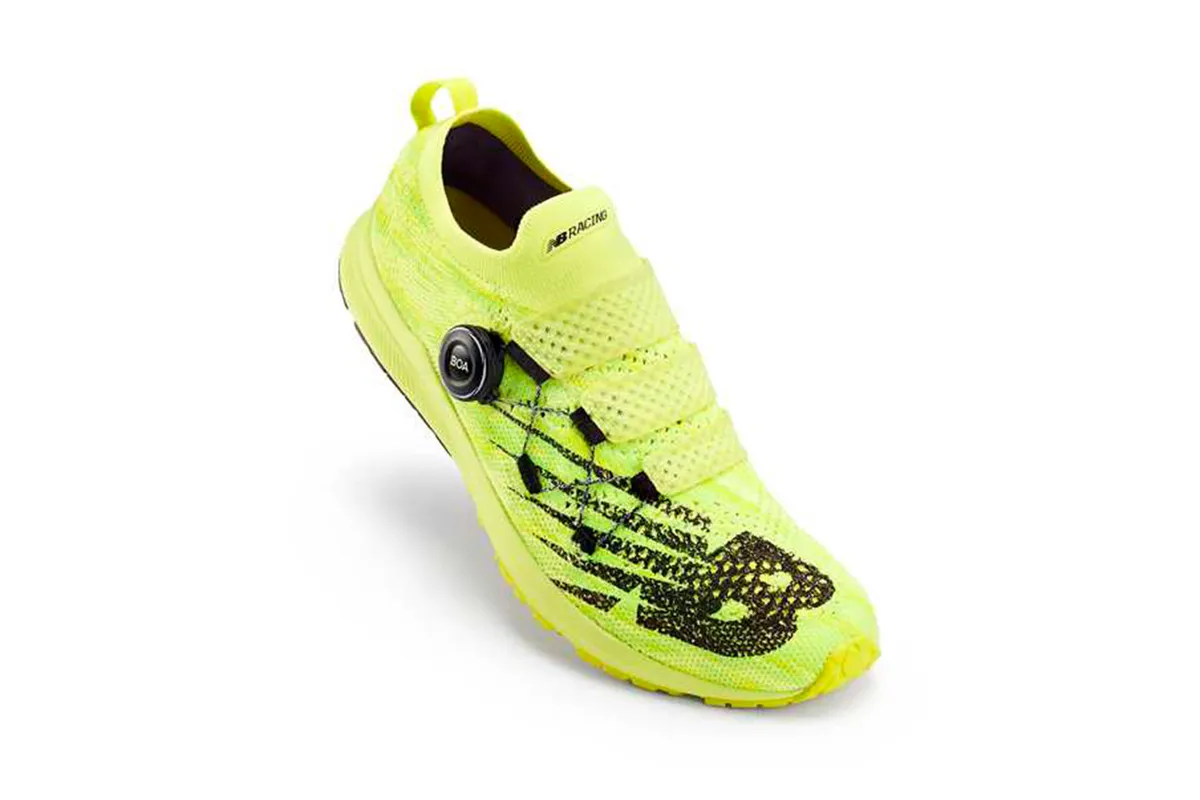
- £110
The 1500T2 is a brash beast – its colourway and Boa closure system screaming triathlon race day. Yet there’s substance behind the shouting as this is one fine shoe. NB has come to terms with Boa.
Gone are hotspots; instead, your foot comfortably clamps into place, all at transition speed. And all without weight as, despite the added circular mechanism, it’s only 232g.
Despite a minimal build, there’s comfort thanks to a REVlite midsole that’s said to be 30% lighter than other foams but without losing stability. The knit uppers add breathability, while a heel loop adds more tri appeal.
Verdict: Transitions– and your final leg – just got brighter
Score: 92%
Top women's race-day runners
On Cloudmonster
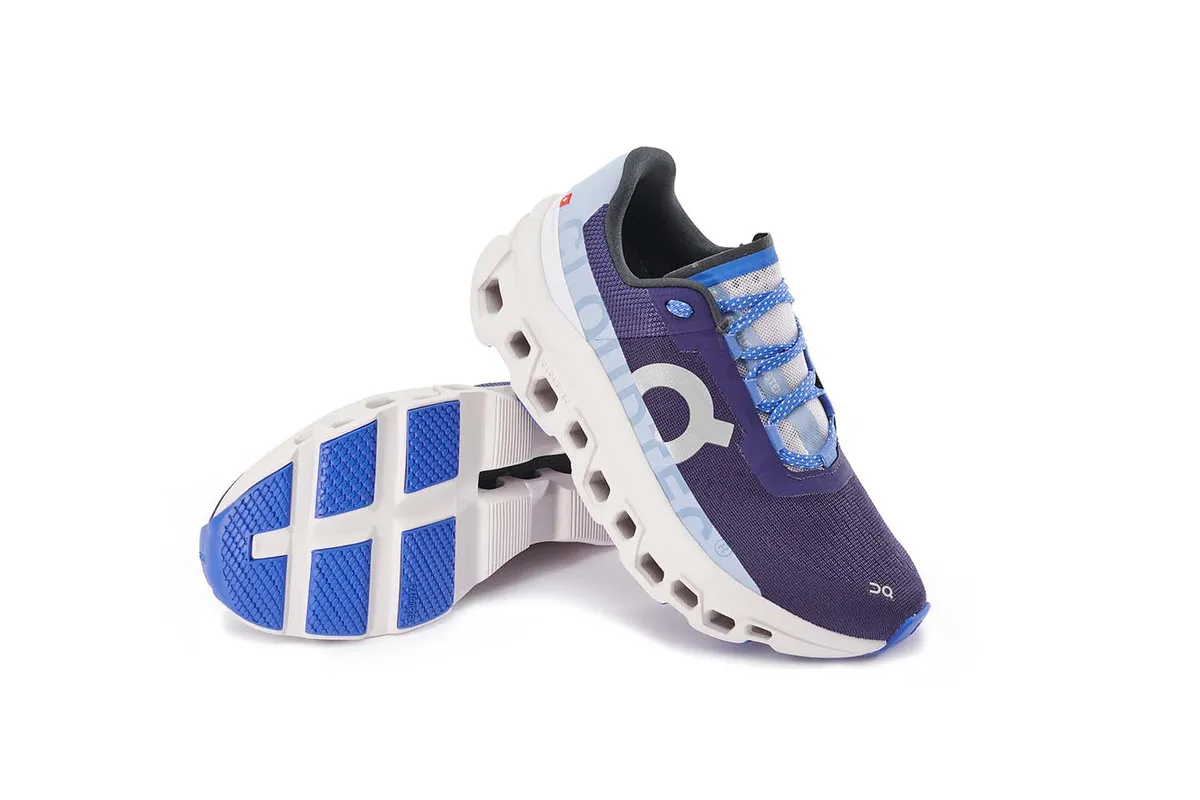
- £150
A bit of an outlier in this test, On’s new Cloudmonster touts cushioning, max bounce and propulsion for logging long miles on the road. It may be the heaviest on test at 232g on our scales (UK5.5), but this comes with a host of advantages including ample cushioning and an extremely springy midsole made up of On’s ‘biggest CloudTec’ lugs ever.
Unlike the Asics and Craft offerings, the Cloudmonster offers ample grip to tackle road running and cornering in all weather conditions. It’s also a roomier option, with the recycled mesh upper and toe-box offering plenty of space for the feet to expand and for those with wider feet.
They’re a little clompy to run in at first, but you soon get used to the 30mm stack height and can then appreciate the impact absorption, coupled with the propulsion from the speedboard.
Verdict: A great pair of kicks, but primed for training rather than tri race days
Score: 80%
Asics Metaspeed Sky
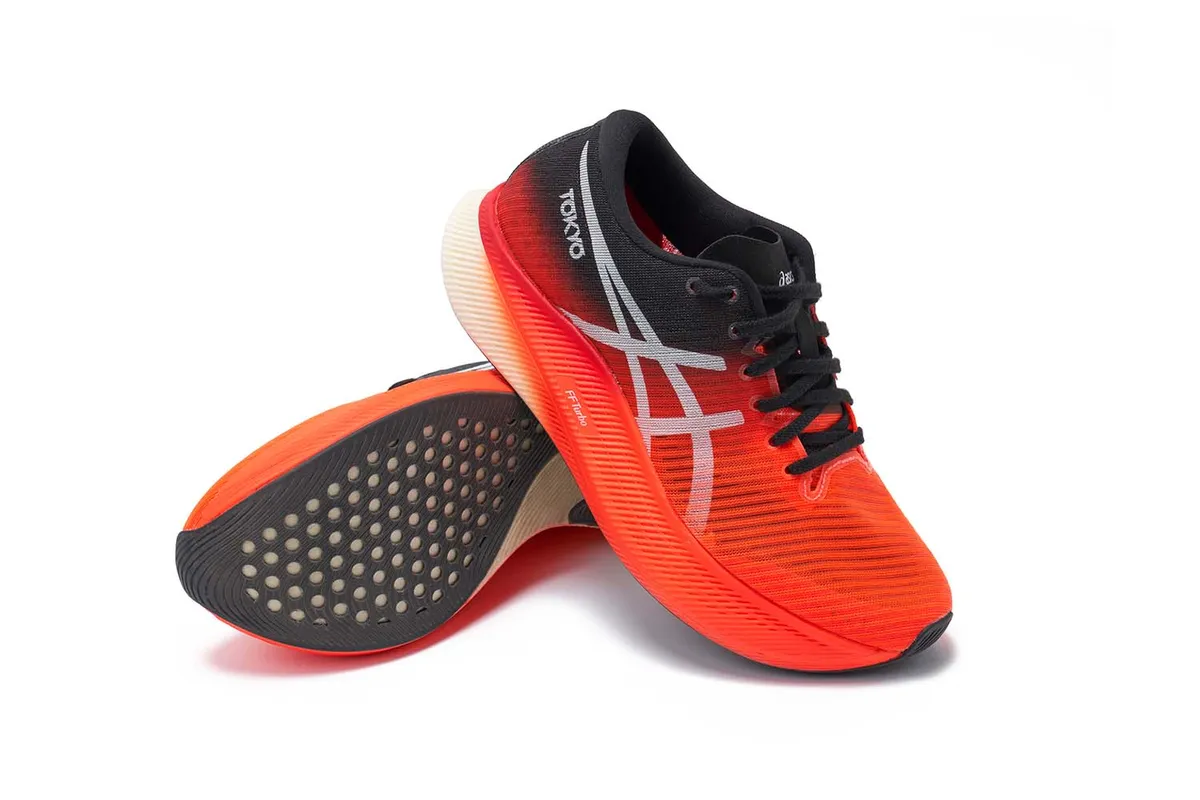
- £225
The Metaspeed’s available in two almost identical looking variations. On test here is the Sky, which is for runners who extend their stride to increase pace.
It has a carbon plate sandwiched within its midsole and a 5mm drop, both of which aim to help you conserve energy and maintain race pace.
Like the Ons, they feature a recycled upper, while breathability is on par with the Crafts. The heel collar has a surprisingly luxurious amount of cushioning considering these are the lightest shoes on test at 166g.
However, our UK5.5 ran considerably small, and we found our toes were squished forwards in the narrow toe-box.
The curved sole’s best suited to midfoot or heel strikers as the outsole felt lacking in grip and left this forefoot striker feeling somewhat unstable in motion. Plus, they’re the coolest looking kicks on test.
Verdict: A well thought-out and lightweight design, but we just didn't gel with these shoes
Score: 82%
Craft CTM Ultra Carbon Race Rebel
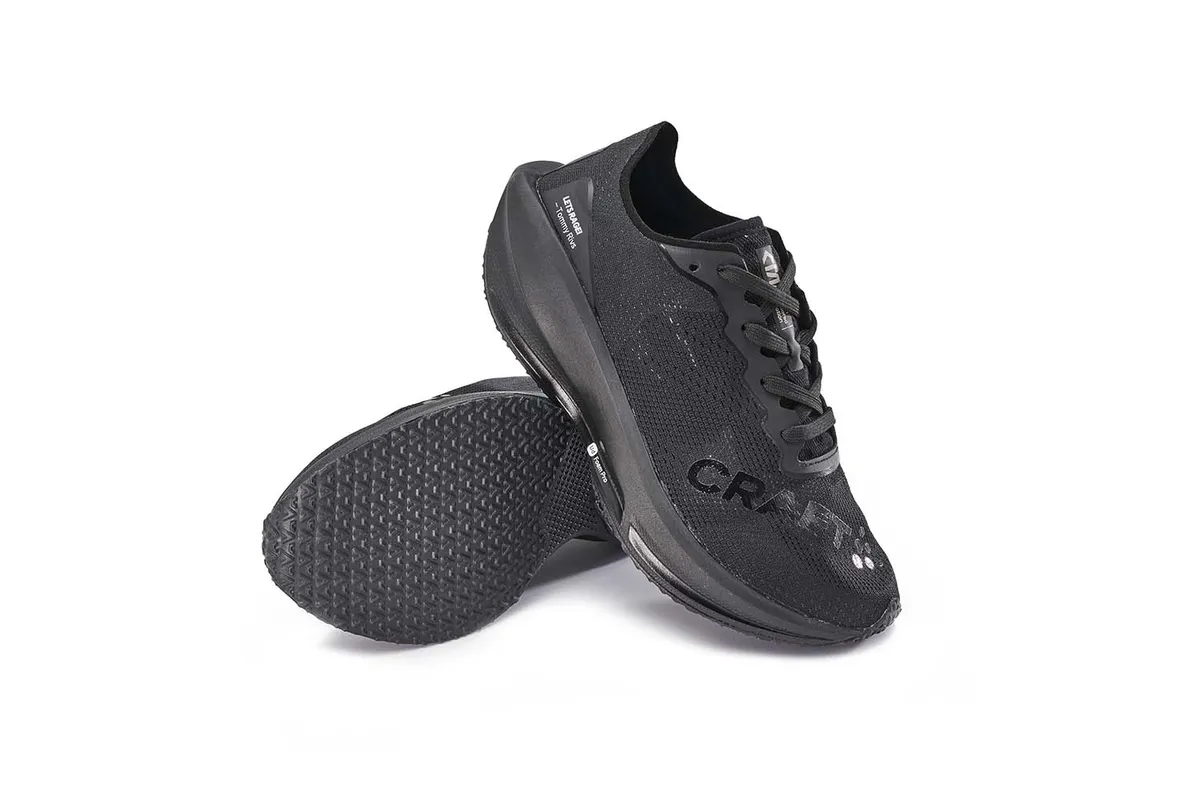
- £220
The Rebel is made for long, fast road miles. Weight saving’s the name of the game here, with the 170g (UK5.5) shoes featuring a simple upper made from ultra-thin and highly breathable polyester mesh.
The theme continues into the lightweight midsole, with a high 33mm stack and 10mm drop that all but flung us forward into action during our 10km tempo sessions.
Like the Asics, the Rebel offers a carbon plate to stabilise and propel the foot strike, but what’s unique about this plate is its y-shape form, which Craft says is to ‘provide ultra-rebound at all angles’, from both the medial and lateral side of the foot.
The slight grip on the sole kept us upright, though we’re not sure how they’d fare in wet conditions. For 70.3 and above, we’d just prefer a tad more support, while the lack of sockliner could spell trouble in T2.
Verdict: Classy and ultra-light race kicks, with all the tech you would want for speedy performance
Score: 90%
Hoka Carbon X3
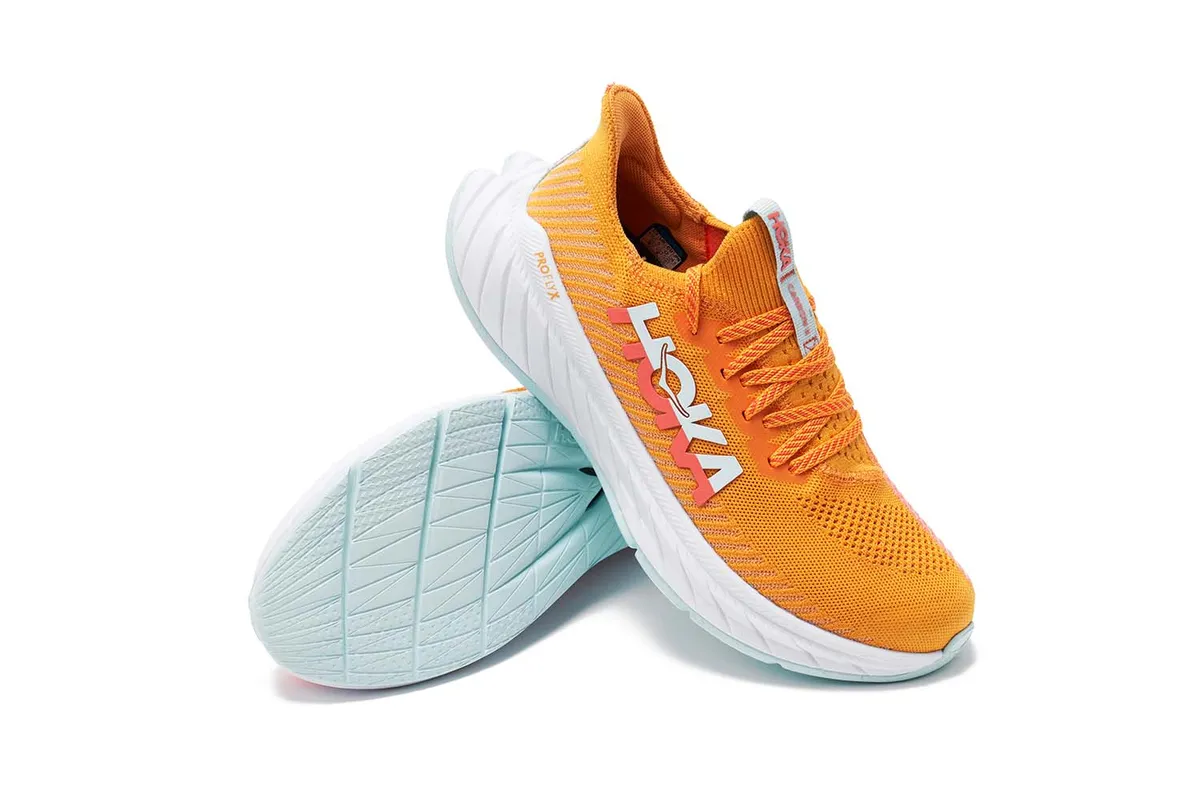
- £160
The Carbon X3 is pitched at athletes looking for ample support and propulsion for fast endurance road racing and training. It looks stylish, feels extremely light at 199g (UK5.5) and is flexible when on.
The material expands comfortably as the foot swells during long runs, while the sock liner and oversized heel tab makes it quick and easy to slip your foot into – ideal for a swift T2.
The heel’s well supported, but the midfoot and forefoot must rely on the large sole and bevelled heel for stability. Meanwhile, the softer EVA midsole is great at absorbing impact and feels soft on the joints.
There’s propulsion a-plenty thanks to the same carbon fibre plate and Meta-Rocker as seen in the X2. The curved geometry with 5mm drop encourages a smooth rolling movement from heelstrike to toe-off, helping to maintain an efficient foot strike.
Verdict: Responsive and light; a race shoe that's well-suited to any distance
Score: 88%
On Cloudflash
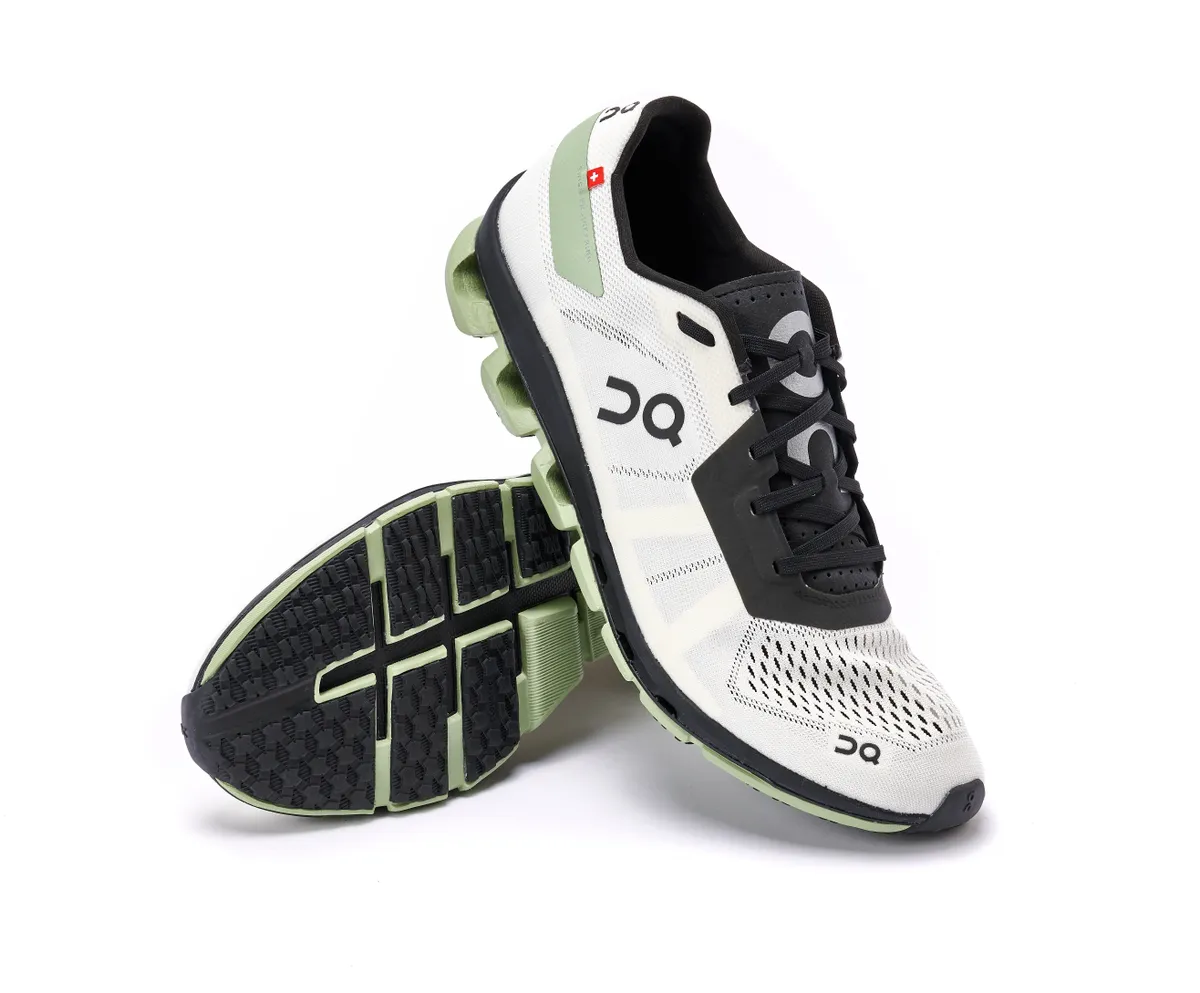
- £130
Hailed as the fastest On ever, the Cloudflash has been designed with the help of elites, including multiple world champ Javier Gomez, for distances up to 10k. At 210g, the Cloudflash felt light and airy and at speed it was one of the top performers.
Two layers of ‘Helion Powered Cloudtec’ offered consistent cushioning throughout the foot roll, which, along with the carbon fibre infused ‘Speedboard’, gave a zippy and responsive race-day feel.
The no-sew support in the forefoot claims to assist feet as they tire towards the end of a race, which may well be true, but as it’s narrower around the forefoot area this would most benefit those with slender feet. For all the tech, laces seem to be have overlooked, with the thin offering creating notable pressure points through the slim tongue.
Verdict: Fast and responsive, just slightly lacking in fit and comfort
Score: 83%
361° Fierce
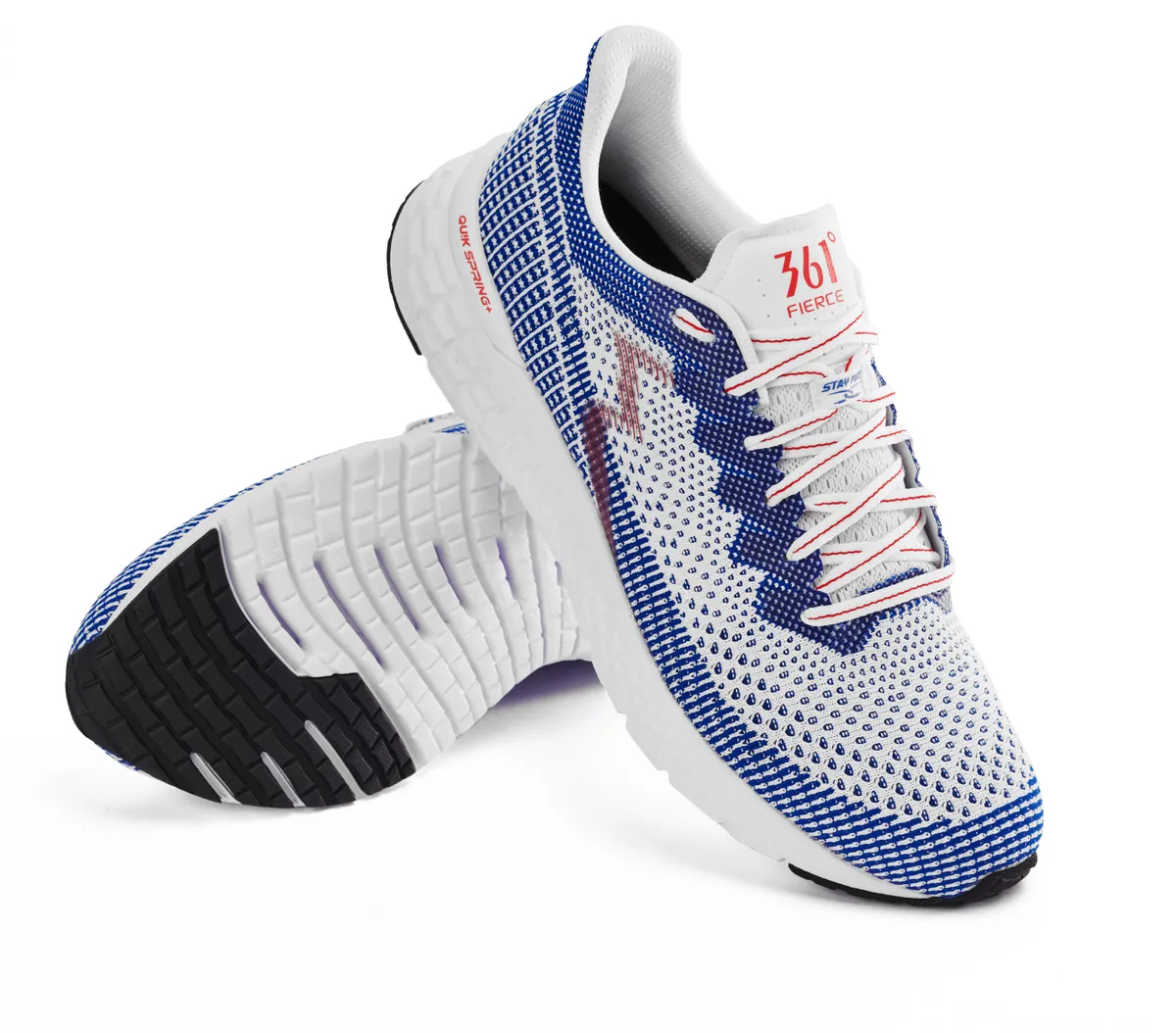
- £109.99
Only founded in 2016, Dutch brand 361° has been put on the map by the Fierce model. With an engineered knit upper and an Ortholite sockliner, they offer cushioning and flexibility while effortlessly moulding around the contours of your foot.
The ‘Stayput’ tongue proved to be comfortable and unobtrusive with the ‘Quickspring’ sole reducing compression and, as the name would suggest, putting a light spring in our step. Although the shoes don’t feel as fast as some, the 361° Fierce performed surprisingly well across all distances.
At 229g they were the heaviest on test, but still felt light and breathable and also offered the most comfort. At shorter distances this may not be a priority, but for 10k they come into their own and allow your feet to feel as fresh as they did in the first km.
Verdict: The Fierce is a great all-rounder option without the hefty price tag
Score: 88%
Topo Athletic Cyclone
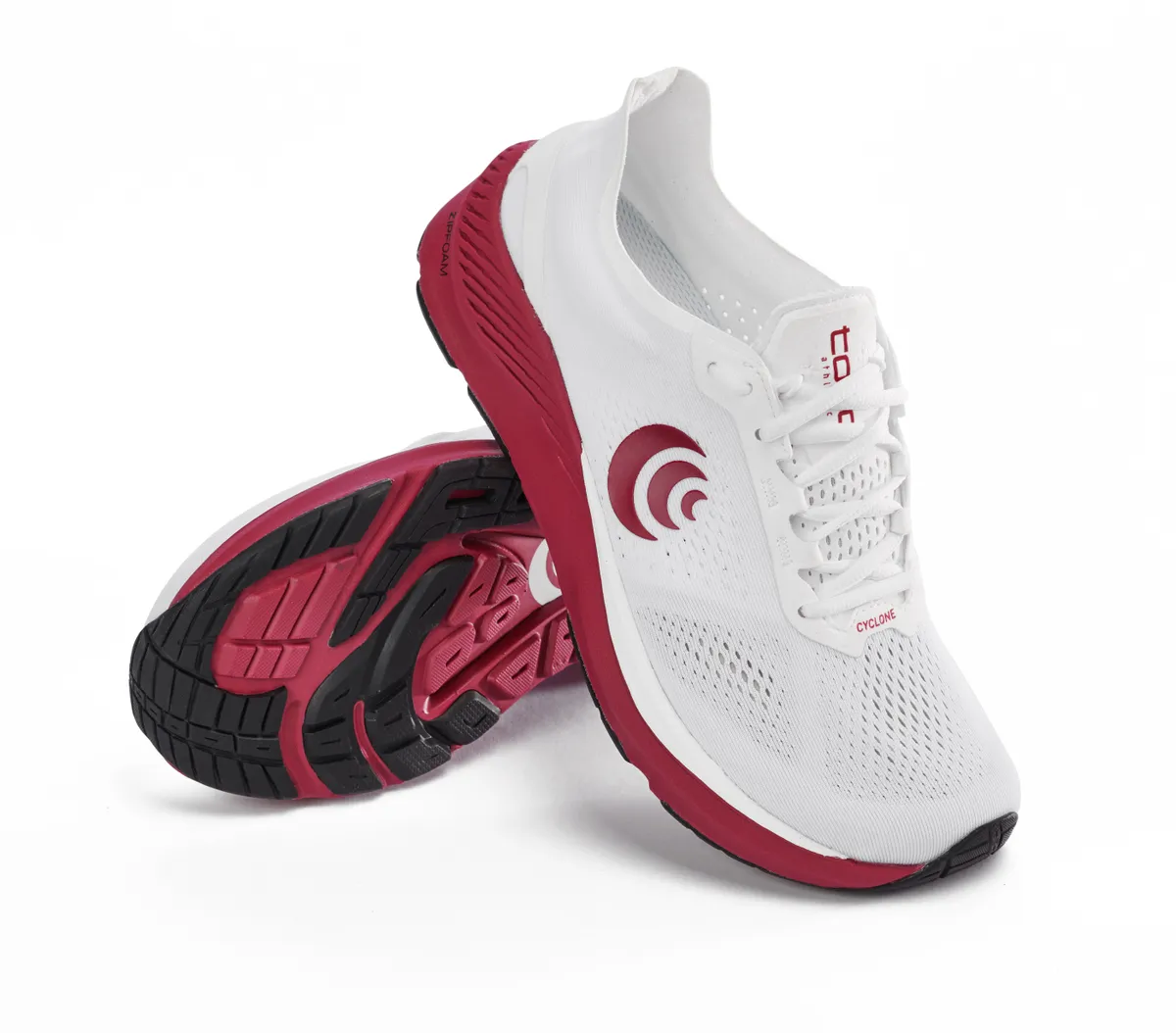
- £120
With a focus on ‘natural running,’ the Cyclone features Topo Athletic’s familiar wider toe box which accommodates toe splay during running. This offers forefoot comfort but also gives the shoe more of a streetwear look.
The sole features a ‘ZipFoam’ core that gives a bouncy feel off the tarmac, while the ortholite footbed offers good arch support and claims to provide anti-compression and anti-microbial properties.
The rubber outsole is designed for increased traction and durability, but it lacked flexibility, resulting in an overly stiff foot roll. The shoe is designed for all distances, which is possibly its failing.
It doesn’t offer top-end speed nor longer distance comfort. Granted, it’s at a lower price-point than some here, but it doesn’t give the same race-ready feel.
Verdict: Performs great as a casual trainer, but is lacking in performance
Score: 79%
Salomon S/Lab Phantasm
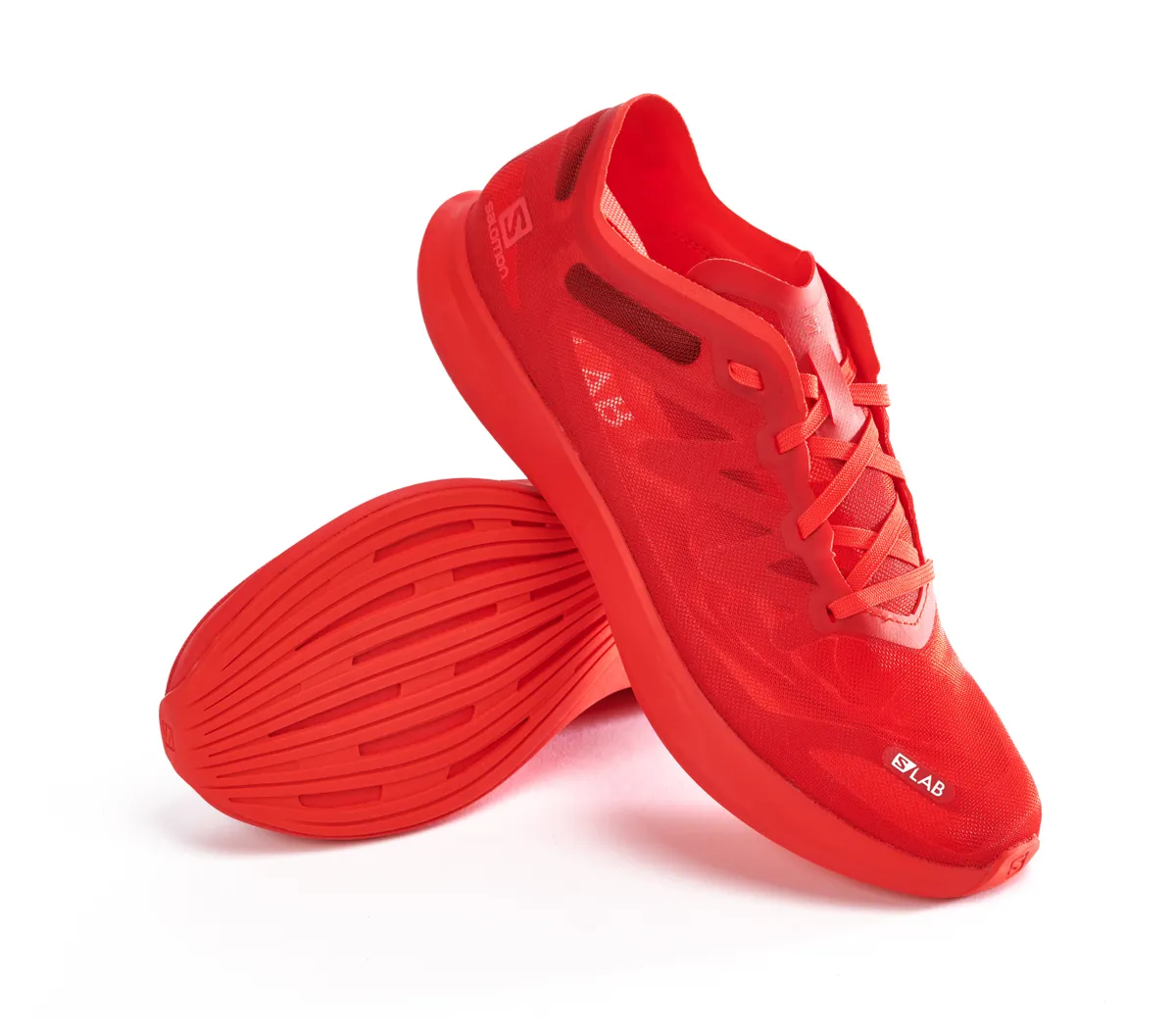
- £165
Bold, bright and daring, the Phantasm is designed to feel dirty fast. The upper mesh is super breathable and featherlight, helping to bring the weight down to only 199g. As a result, there’s minimal cushioning, but there’s still support where needed.
The reverse camber design means you spend less time on the ground, while the midsole is designed to deliver a bouncy energy return, which, despite being a forefoot design, gives plenty of support around the midfoot and arch.
The Contagrip sole has flat wide lugs, designed to grip on flat hard surfaces. Over the shorter distances, the Phantasm was lightning fast so if you’re looking for 5k PBs, this is the number one choice. But for training or anything above 10km, you’ll want something a bit more forgiving.
Verdict: If you can justify two separate shoes for racing/training, this one will fly
Score: 86%
Newton Gravity 10
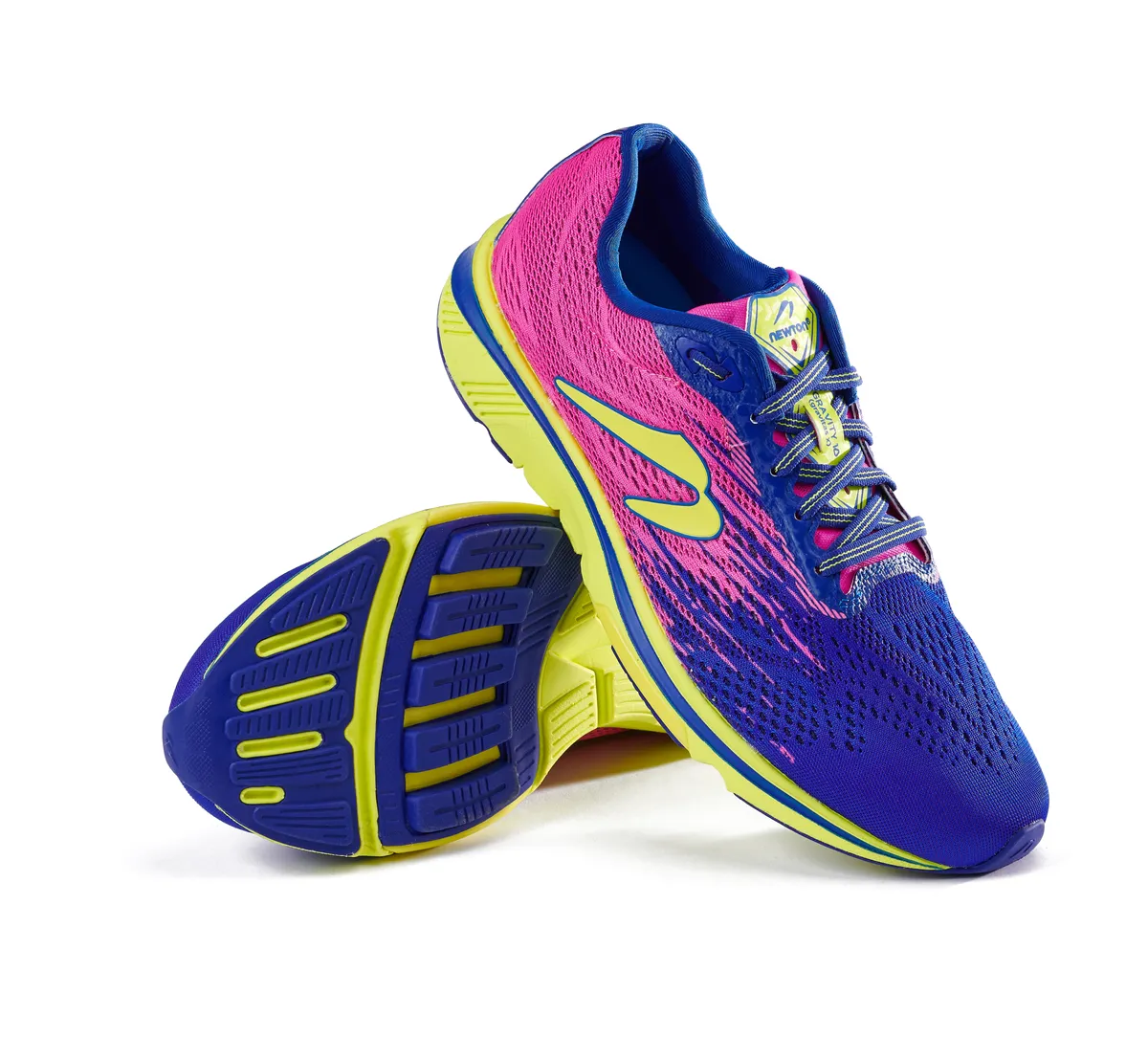
- £155
The eye-catching Gravity 10 is setting new standards when it comes to sustainability. The laces and mesh upper are made from 100% recycled material while the EcoPure sole is designed to breakdown into nontoxic biomatter 75% quicker than standard trainers.
The gender-tuned fit is snug but comfortable and flexes to support your foot’s natural movement. At 204g they’re breathable and light, while Newton’s distinctive ‘lugs’ come with Action/ Reaction technology that increases responsiveness and reduces energy loss with every stride, making them one of the fastest shoes on test.
For those new to Newtons, the minimal 3mm drop claims to be the most natural position to run in but adjusting to this can take time. For those who persevere, the Gravity will reward
Verdict: Sustainability and performance in one package; hard not to be impressed
Score: 89%
How to choose triathlon running shoes
Finding the right pair of triathlon shoes for your running style and needs can be confusing, but there are a few key features that are important to look out for in your next pair of racing trainers.
Firstly, consider what terrain you’ll be running on and over what distance. If the run leg of your race is on road and especially for the longer distances, you’ll need to think about what cushioning and support your feet need to cope with the high impact of tarmac. If you’re after an off-road pair, we’ve got you covered with an extensive round-up of the best trail shoes reviewed.
Beyond cushioning levels, triathlon race-day run shoes should be as light-weight as possible to help you maintain a high speed and cadence. Some other triathlon-specific features include elastic laces and heel loops for quick transitions, and drainage holes so your feet aren't weighed down by the rain when racing in bad weather.
